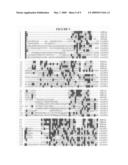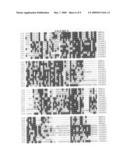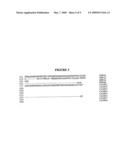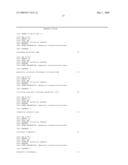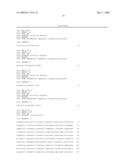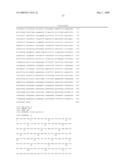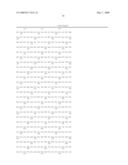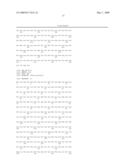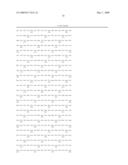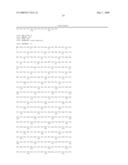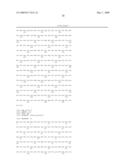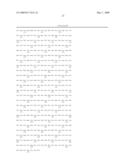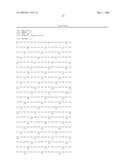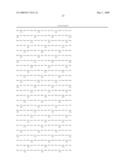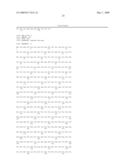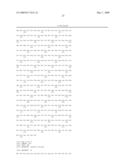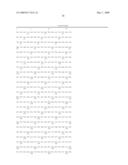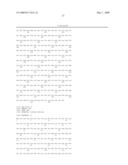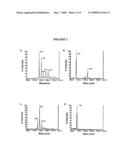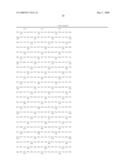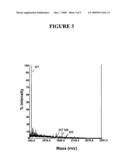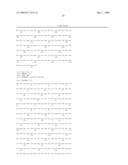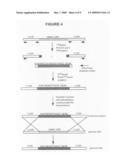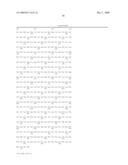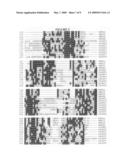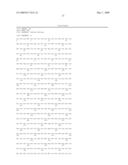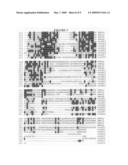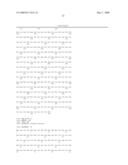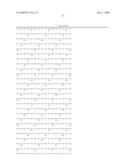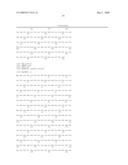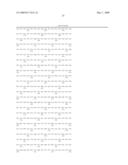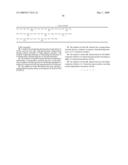Patent application title: Methods for reducing or eliminating alpha-mannosidase resistant glycans for the production of glycoproteins
Inventors:
Piotr Bobrowicz (White River Junction, VT, US)
IPC8 Class: AC12P2104FI
USPC Class:
435 691
Class name: Chemistry: molecular biology and microbiology micro-organism, tissue cell culture or enzyme using process to synthesize a desired chemical compound or composition recombinant dna technique included in method of making a protein or polypeptide
Publication date: 2009-05-07
Patent application number: 20090117616
Claims:
1-19. (canceled)
20. A method for producing glycoprotein compositions in Pichia pastoris host cells, said glycoprotein compositions having reduced amounts of high mannose glycans, said method comprising reducing or eliminating the presence of α-mannosidase resistant glycans on said glycoproteins.
21. The method of claim 19, wherein the step of reducing or eliminating α-mannosidase resistant glycans on glycoproteins comprises modifying the host cell through disruption or deletion of a gene involved in β-mannosylation of N-glycans.
22. The method of claim 20 wherein the gene encodes a polypeptide having the amino acid sequence set forth in SEQ ID NO:12.
23. The method of claim 19, wherein the α-mannosidase resistant glycans comprise α-mannose, branched high mannose, or α-1,4 mannose residues.
24. The method of claim 20, wherein the host cell further comprises deletion of a functional gene product encoding an alpha-1,6-mannosyltransferase activity.
25. The method of claim 20, wherein the host cell further comprises deletion of a functional gene product encoding mannosylphosphate transferase activity.
Description:
CROSS-REFERENCE TO RELATED APPLICATIONS
[0001]This application is a continuation of U.S. application Ser. No. 11/118,008, filed--Apr. 29, 2005, and which claims benefit of--U.S. provisional application Ser. No. 60/620,186 filed on Oct. 18, 2004, which are incorporated by reference herein in its entirety.
FIELD OF THE INVENTION
[0002]The present invention relates to the field of protein glycosylation engineering in lower eukaryotes. The present invention further relates to engineering of yeast and filamentous fungal host cells for the production of therapeutic glycoproteins. In particular, the present invention relates to the reduction or elimination of α-mannosidase resistant glycans on glycoproteins, and methods for reducing or eliminating a gene involved in the production of α-mannosidase resistance on glycans in yeast cells.
BACKGROUND OF THE INVENTION
[0003]The ability to produce recombinant human proteins has led to major advances in human health care and remains an active area of drug discovery. Many therapeutic proteins require the posttranslational addition of glycans to specific asparagine residues (N-glycosylation) of the protein to ensure proper structure-function activity and subsequent stability in human serum. For therapeutic use in humans, glycoproteins require human-like N-glycosylation. Mammalian cell lines (e.g., CHO cells, human retinal cells) that can mimic human-like glycoprotein processing have several drawbacks including low protein titers, long fermentation times, heterogeneous products, and continued viral containment. It is therefore desirable to use an expression system that not only produces high protein titers with short fermentation times, but can also produce human-like glycoproteins.
[0004]Fungal hosts such as the methylotrophic yeast Pichia pastoris has distinct advantages for therapeutic protein expression--e.g. it does not secrete high amounts of endogenous proteins, it has a strong inducible promoter, it can be grown in defined chemical media, and it can produce high titers of recombinant proteins (Cregg et al., 2000). However, glycosylated proteins expressed in P. pastoris contain additional mannose sugars resulting in "high mannose" glycans, as well as mannosylphosphate groups which impart a negative charge onto glycoproteins. Glycoproteins with either high mannose glycans or charged mannans are a high risk for illiciting an immune response in humans (Takeuchi, 1997; Rosenfeld and Ballou, 1974). Accordingly, it is desirable to produce therapeutic glycoproteins in fungal host systems, such that the pattern of glycosylation is identical or at least similar to that in humans.
[0005]Some fungal hosts contain immunogenic β-mannosylation on glycans of glycoproteins. In order to circumvent antigenicity, it is desirable to eliminate β-mannosylation in the production of human-like glycoproteins. Oligomannosides with β-1,2-linkage were first described by Shibata et al., (1985) in association with Candida albicans cell wall phosphopeptidomannan by phosphodiester bridges. Subsequently, three types of β-1,2 linkages have been identified in the side chains of Candida cell wall mannans. The first is a β-1,2-linked manno-oligomer located in a phosphodiesterified oligosaccharide moiety which is a common epitope in the mannans of several Candida species (Shibata et al 1993a). The second type is a β-1,2-linked mannose unit attached to the nonreducing terminal of the α-1,2 oligomannosyl side chains in the mannans of Candida albicans, tropicalis and glabrata (Kobayashi et al., 1989, 1992 and 1994). The third type of β-1,2 linkage is found in Candida guilliermondii and contains α-1,2 linked mannose units attached to an α-1,3 linked mannose unit (Shibata et al., 1993b).
[0006]Despite these findings, the studies on β-1,2 linkages have been limited by unsuccessful attempts to identify a β-1,2 mannosyl-transferase gene. Suzuki et al., (1997) characterized the presence of a β-1,2-mannosyltransferase in Candida guilliermondii, however, a gene for this enzyme has yet to be cloned.
[0007]In C. albicans yeast, both the β-oligomannosides which make up the acid-labile region of the phosphomannan complex, and α-oligomannosides, which make up the acid-stable region of the complex, serve as adhesins in the attachment of these pathogenic yeast cells to host splenic and lymph node macrophages (Cutler, 2001). Interestingly, antibodies protective against various forms of candidiasis recognize β-linked mannotriose, but not oligomannosides of greater mannose chain length (Han et al, 1997). It was reported that patients who develop deep tissue invasion with C. albicans, do not have detectable antibody titers specific for β-linked oligomannosides, whereas such antibodies were present in healthy individuals (Jouault et al, 1997).
[0008]There are few examples of β-linked mannose residues on glycoproteins from P. pastoris. In 1986, Kobayashi et al, described a modified acetolysis method with milder conditions for the isolation of manno-oligosaccharides composed predominantly of β-1,2 linked mannose residues. In 2003, Trimble et al reported the presence of β-1,2-linked mannose residues in the recombinant human bile salt-stimulated lipase (hBSSL) expressed in P. pastoris. As evidenced by the presence of protective antibodies in uninfected individuals, β-linked mannans are likely to be immunogenic. Additionally, exposed mannose groups on therapeutic proteins are rapidly cleared by mannose receptors on macrophage cells, resulting in low drug efficacy. Thus, the presence of α-linked mannose residues on N- or O-linked glycans of heterologous therapeutic proteins expressed in a fungal host e.g., P. pastoris is not desirable given their immunogenic potential and their ability to bind to clearance factors.
[0009]What is needed, therefore, is a method for removing undesired mannose residues on glycoproteins for the production of therapeutic glycoproteins.
SUMMARY OF INVENTION
[0010]Accordingly, the present invention provides methods for producing glycoprotein compositions in yeast or filamentous fungal host cells, said glycoprotein compositions having reduced amounts of high mannose glycans, said method comprising reducing or eliminating the presence of α-mannosidase resistant glycans on said glycoproteins. In certain embodiments, reducing or eliminating α-mannosidase resistant glycans on glycoproteins is accomplished by modifying the host cell through disruption, deletion or mutation of a gene involved in mannosylation of N-glycans. Such genes may include, for example, the gene sequences described herein as SEQ ID NO: 11 or variants thereof.
[0011]In certain embodiments, the α-mannosidase resistant glycans may comprise β-mannose, branched high mannose, or α-1,4 mannose residues.
[0012]The host cells of the present invention are preferably of yeast and/or filamentous fungal origin. The host cells useful in the present invention may include the following families, genie, and species: Pichia pastoris, Pichia finlandica, Pichia trehalophila, Pichia koclamae, Pichia membranaefaciens, Pichia methanolica, Pichia minuta (Ogataea minuta, Pichia lindneri), Pichia opuntiae, Pichia thermotolerans, Pichi salictaria, Pichia guercum, Pichia pijperi, Pichia stiptis, Pichia sp., Saccharomyces castellii, Saccharomyces cerevisiae, Saccharomyces kluyveri, Saccharomyces sp., Hansenulapolymorpha, Kluyveromyces sp., Kluyveromyces lactis, Candida albicans, Candida sp., Aspergillusfumigatus, Aspergillus nidulans, Aspergillus niger, Aspergillus oryzae, Trichoderma reesei, Chrysosporium lucknowense, Fusarium sp., Fusarium gramineum, Fusarium venenatum, Physcomitrella patens and Neurospora crassa.
[0013]In certain embodiments, the host cells of the present invention may comprise a deletion of a functional gene encoding an alpha-1,6-mannosyltransferase activity, such as OCH1. In other embodiments, the host cells of the present invention may further comprise a gene encoding an mannosylphosphate transferase activity, such as PNO1 and MNN4B.
[0014]The present invention also provides glycoprotein compositions with reduced amounts of high mannose glycan structures that are recalcitrant to α-mannosidase, which may be produced by the methods of the present invention. Such glycoprotein compositions may comprise either N-linked glycans and/or O-linked glycans.
[0015]The present invention further provides isolated nucleic acid sequences which are involved in the production of α-mannosidase resistant glycans. These isolated nucleic acid sequences include the sequences described herein as SEQ ID NO: 11 or variants thereof. Also included in the present invention are other nucleic acid sequences which exhibit structural similarity to the above sequences. These may include, for example, degenerate variants of SEQ ID NO: 11 as well as nucleic acid sequences having a high level of nucleotide sequence identity with the above. Nucleic acid sequences included in the present invention would therefore include those nucleic acid sequences having at least 72% 75%, 80% or 85% 90%, 95%, 98%, 99%, 99.9% identity to the sequences of SEQ ID NO: 11 as well as nucleic acid sequences that encode a polypeptide having the amino acid sequences which is produced by SEQ ID NO: 11; nucleic acid sequence that encode polypeptides having at least 72% 75%, 80% or 85% 90%, 95%, 98%, 99%, 99.9% identity to the polypeptides having the amino acid sequences which are produced by SEQ ID NO: 12, SEQ ID NO: 13, SEQ ID NO: 14, or SEQ ID NO: 15; and nucleic acid sequences that hybridize under stringent conditions to the nucleic acid sequences described as SEQ ID NO: 11. The present invention also includes nucleic acid sequences comprising a fragment of any of the above nucleic acid sequences that is at least 60 contiguous nucleotides in length.
[0016]In still other embodiments, the present invention provides modified yeast or filamentous fungal host cells. The host cells of the present invention may be characterized as having been modified to reduce expression of the functional gene products of one or more a nucleic acid sequence selected from the group consisting of SEQ ID NO: 11. In certain embodiments, the modified host cell comprises a disruption, deletion or mutation in one or more nucleic acid sequences selected from the group consisting of SEQ ID NO: 11. In other embodiments, the modified host cell comprises a cellular inhibitor of expression of the functional gene product of a nucleic acid selected from the group consisting of SEQ ID NO: 11 or variants thereof. Cellular inhibitors of expression useful for the present invention include, for example antisense DNA and short interfering RNA.
[0017]In other embodiments, the present invention may comprise modified yeast or filamentous fungal host cells which are capable of expressing glycoprotein compositions having reduced amounts of high mannose glycans, said glycoprotein compositions comprising reduced presence of α-mannosidase resistant glycans, for example β-mannosyl residues.
BRIEF DESCRIPTION OF THE DRAWINGS
[0018]FIG. 1 depicts the nucleic acid (SEQ ID NO: 11) and amino acid sequence (SEQ ID NO: 12) of the P. pastoris AMR2 gene.
[0019]FIG. 2 A. MALDI-TOF MS showing the N-glycans of P. pastoris YAS137 (Δoch1, Δpno1, Δmnn4b). B. MALDI-TOF MS showing the N-glycans of P. pastoris YAS137 after digestion with α-1,2 mannosidase. C. MALDI-TOF MS showing the N-glycans of P. pastoris PBP130 (Δoch1, Δpno1, Δmnn4b, Δamr2). D. MALDI-TOF MS showing the N-glycans of P. pastoris PBP130 (Δoch1, Δpno1, Δmnn4b, Δamr2) after digestion with α-1,2 mannosidase.
[0020]FIG. 3 MALDI-TOF MS spectra of the N-glycans of P. pastoris YAS137 after digestion with α-1,2 mannosidase and Jack Bean mannosidase.
[0021]FIG. 4 illustrates the fusion PCR knock-out strategy of P. pastoris AMR2 using the drug resistance marker, kanamycin.
[0022]FIG. 5 The deduced amino acid sequence of the P. pastoris AMR2 gene is shown aligned with the amino acid sequence of AMR2 homologs from Candida albicans. AMR2p (SEQ ID NO:12), AMR1p (SEQ ID NO:13), AMR3p (SEQ ID NO:14), AMR4p (SEQ ID NO:15), CaORF1 (SEQ ID NO:16), CaORF2 (SEQ ID NO:17), CaORF3 (SEQ ID NO:18), CaORF4 (SEQ ID NO:19), CaORF5 (SEQ ID NO:20), CaORF6 (SEQ ID NO:21), CaORF7 (SEQ ID NO:22), CaORF8 (SEQ ID NO:23).
DETAILED DESCRIPTION OF THE INVENTION
[0023]Unless otherwise defined herein, scientific and technical terms used in connection with the present invention shall have the meanings that are commonly understood by those of ordinary skill in the art. Further, unless otherwise required by context, singular terms shall include the plural and plural terms shall include the singular. Generally, nomenclatures used in connection with, and techniques of biochemistry, enzymology, molecular and cellular biology, microbiology, genetics and protein and nucleic acid chemistry and hybridization described herein are those well known and commonly used in the art. The methods and techniques of the present invention are generally performed according to conventional methods well known in the art and as described in various general and more specific references that are cited and discussed throughout the present specification unless otherwise indicated. See, e.g., Sambrook et al. Molecular Cloning: A Laboratory Manual, 2d ed., Cold Spring Harbor Laboratory Press, Cold Spring Harbor, N.Y. (1989); Ausubel et al., Current Protocols in Molecular Biology, Greene Publishing Associates (1992, and Supplements to 2002); Harlow and Lane, Antibodies: A Laboratory Manual, Cold Spring Harbor Laboratory Press, Cold Spring Harbor, N.Y. (1990); Taylor and Drickamer, Introduction to Glycobiology, Oxford Univ. Press (2003); Worthington Enzyme Manual, Worthington Biochemical Corp., Freehold, N.J.; Handbook of Biochemistry: Section A Proteins, Vol I, CRC Press (1976); Handbook of Biochemistry. Section A Proteins, Vol II, CRC Press (1976); Essentials of Glycobiology, Cold Spring Harbor Laboratory Press (1999).
[0024]All publications, patents and other references mentioned herein are hereby incorporated by reference in their entireties.
[0025]The following terms, unless otherwise indicated, shall be understood to have the following meanings:
[0026]The term "polynucleotide" or "nucleic acid molecule" refers to a polymeric form of nucleotides of at least 10 bases in length. The term includes DNA molecules (e.g., cDNA or genomic or synthetic DNA) and RNA molecules (e.g., mRNA or synthetic RNA), as well as analogs of DNA or RNA containing non-natural nucleotide analogs, non-native internucleoside bonds, or both. The nucleic acid can be in any topological conformation. For instance, the nucleic acid can be single-stranded, double-stranded, triple-stranded, quadruplexed, partially double-stranded, branched, hairpinned, circular, or in a padlocked conformation.
[0027]Unless otherwise indicated, a "nucleic acid comprising SEQ ID NO:X" refers to a nucleic acid, at least a portion of which has either (i) the sequence of SEQ ID NO:X, or (ii) a sequence complementary to SEQ ID NO:X. The choice between the two is dictated by the context. For instance, if the nucleic acid is used as a probe, the choice between the two is dictated by the requirement that the probe be complementary to the desired target.
[0028]An "isolated" or "substantially pure" nucleic acid or polynucleotide (e.g., an RNA, DNA or a mixed polymer) is one which is substantially separated from other cellular components that naturally accompany the native polynucleotide in its natural host cell, e.g., ribosomes, polymerases and genomic sequences with which it is naturally associated. The term embraces a nucleic acid or polynucleotide that (1) has been removed from its naturally occurring environment, (2) is not associated with all or a portion of a polynucleotide in which the "isolated polynucleotide" is found in nature, (3) is operatively linked to a polynucleotide which it is not linked to in nature, or (4) does not occur in nature. The term "isolated" or "substantially pure" also can be used in reference to recombinant or cloned DNA isolates, chemically synthesized polynucleotide analogs, or polynucleotide analogs that are biologically synthesized by heterologous systems.
[0029]However, "isolated" does not necessarily require that the nucleic acid or polynucleotide so described has itself been physically removed from its native environment. For instance, an endogenous nucleic acid sequence in the genome of an organism is deemed "isolated" herein if a heterologous sequence is placed adjacent to the endogenous nucleic acid sequence, such that the expression of this endogenous nucleic acid sequence is altered. In this context, a heterologous sequence is a sequence that is not naturally adjacent to the endogenous nucleic acid sequence, whether or not the heterologous sequence is itself endogenous (originating from the same host cell or progeny thereof) or exogenous (originating from a different host cell or progeny thereof). By way of example, a promoter sequence can be substituted (e.g., by homologous recombination) for the native promoter of a gene in the genome of a host cell, such that this gene has an altered expression pattern. This gene would now become "isolated" because it is separated from at least some of the sequences that naturally flank it.
[0030]A nucleic acid is also considered "isolated" if it contains any modifications that do not naturally occur to the corresponding nucleic acid in a genome. For instance, an endogenous coding sequence is considered "isolated" if it contains an insertion, deletion or a point mutation introduced artificially, e.g., by human intervention. An "isolated nucleic acid" also includes a nucleic acid integrated into a host cell chromosome at a heterologous site and a nucleic acid construct present as an episome. Moreover, an "isolated nucleic acid" can be substantially free of other cellular material, or substantially free of culture medium when produced by recombinant techniques, or substantially free of chemical precursors or other chemicals when chemically synthesized.
[0031]As used herein, the phrase "degenerate variant" of a reference nucleic acid sequence encompasses nucleic acid sequences that can be translated, according to the standard genetic code, to provide an amino acid sequence identical to that translated from the reference nucleic acid sequence. The term "degenerate oligonucleotide" or "degenerate primer" is used to signify an oligonucleotide capable of hybridizing with target nucleic acid sequences that are not necessarily identical in sequence but that are homologous to one another within one or more particular segments.
[0032]The term "percent sequence identity" or "identical" in the context of nucleic acid sequences refers to the residues in the two sequences which are the same when aligned for maximum correspondence. The length of sequence identity comparison may be over a stretch of at least about nine nucleotides, usually at least about 20 nucleotides, more usually at least about 24 nucleotides, typically at least about 28 nucleotides, more typically at least about 32 nucleotides, and preferably at least about 36 or more nucleotides. There are a number of different algorithms known in the art which can be used to measure nucleotide sequence identity. For instance, polynucleotide sequences can be compared using FASTA, Gap or Bestfit, which are programs in Wisconsin Package Version 10.0, Genetics Computer Group (GCG), Madison, Wis. FASTA provides alignments and percent sequence identity of the regions of the best overlap between the query and search sequences. Pearson, Methods Enzymol. 183:63-98 (1990) (hereby incorporated by reference in its entirety). For instance, percent sequence identity between nucleic acid sequences can be determined using FASTA with its default parameters (a word size of 6 and the NOPAM factor for the scoring matrix) or using Gap with its default parameters as provided in GCG Version 6.1, herein incorporated by reference. Alternatively, sequences can be compared using the computer program, BLAST (Altschul et al., J. Mol. Biol. 215:403-410 (1990); Gish and States, Nature Genet. 3:266-272 (1993); Madden et al., Meth. Enzymol. 266:131-141 (1996); Altschul et al., Nucleic Acids Res. 25:3389-3402 (1997); Zhang and Madden, Genome Res. 7:649-656 (1997)), especially blastp or tblastn (Altschul et al., Nucleic Acids Res. 25:3389-3402 (1997)).
[0033]The term "substantial homology" or "substantial similarity," when referring to a nucleic acid or fragment thereof, indicates that, when optimally aligned with appropriate nucleotide insertions or deletions with another nucleic acid (or its complementary strand), there is nucleotide sequence identity in at least about 50%, more preferably 60% of the nucleotide bases, usually at least about 70%, more usually at least about 80%, preferably at least about 90%, and more preferably at least about 95%, 96%, 97%, 98% or 99% of the nucleotide bases, as measured by any well-known algorithm of sequence identity, such as FASTA, BLAST or Gap, as discussed above.
[0034]Alternatively, substantial homology or similarity exists when a nucleic acid or fragment thereof hybridizes to another nucleic acid, to a strand of another nucleic acid, or to the complementary strand thereof, under stringent hybridization conditions. "Stringent hybridization conditions" and "stringent wash conditions" in the context of nucleic acid hybridization experiments depend upon a number of different physical parameters. Nucleic acid hybridization will be affected by such conditions as salt concentration, temperature, solvents, the base composition of the hybridizing species, length of the complementary regions, and the number of nucleotide base mismatches between the hybridizing nucleic acids, as will be readily appreciated by those skilled in the art. One having ordinary skill in the art knows how to vary these parameters to achieve a particular stringency of hybridization.
[0035]In general, "stringent hybridization" is performed at about 25° C. below the thermal melting point (Tm) for the specific DNA hybrid under a particular set of conditions. "Stringent washing" is performed at temperatures about 5° C. lower than the Tm for the specific DNA hybrid under a particular set of conditions. The Tm is the temperature at which 50% of the target sequence hybridizes to a perfectly matched probe. See Sambrook et al., Molecular Cloning: A Laboratory Manual, 2d ed., Cold Spring Harbor Laboratory Press, Cold Spring Harbor, N.Y. (1989), page 9.51, hereby incorporated by reference. For purposes herein, "stringent conditions" are defined for solution phase hybridization as aqueous hybridization (i.e., free of formamide) in 6×SSC (where 20×SSC contains 3.0 M NaCl and 0.3 M sodium citrate), 1% SDS at 65° C. for 8-12 hours, followed by two washes in 0.2×SSC, 0.1% SDS at 65° C. for 20 minutes. It will be appreciated by the skilled worker that hybridization at 65° C. will occur at different rates depending on a number of factors including the length and percent identity of the sequences which are hybridizing.
[0036]The nucleic acids (also referred to as polynucleotides) of this invention may include both sense and antisense strands of RNA, cDNA, genomic DNA, and synthetic forms and mixed polymers of the above. They may be modified chemically or biochemically or may contain non-natural or derivatized nucleotide bases, as will be readily appreciated by those of skill in the art. Such modifications include, for example, labels, methylation, substitution of one or more of the naturally occurring nucleotides with an analog, internucleotide modifications such as uncharged linkages (e.g., methyl phosphonates, phosphotriesters, phosphoramidates, carbamates, etc.), charged linkages (e.g., phosphorothioates, phosphorodithioates, etc.), pendent moieties (e.g., polypeptides), intercalators (e.g., acridine, psoralen, etc.), chelators, alkylators, and modified linkages (e.g., alpha anomeric nucleic acids, etc.) Also included are synthetic molecules that mimic polynucleotides in their ability to bind to a designated sequence via hydrogen bonding and other chemical interactions. Such molecules are known in the art and include, for example, those in which peptide linkages substitute for phosphate linkages in the backbone of the molecule. Other modifications can include, for example, analogs in which the ribose ring contains a bridging moiety or other structure such as the modifications found in "locked" nucleic acids.
[0037]The term "mutated" when applied to nucleic acid sequences means that nucleotides in a nucleic acid sequence may be inserted, deleted or changed compared to a reference nucleic acid sequence. A single alteration may be made at a locus (a point mutation) or multiple nucleotides may be inserted, deleted or changed at a single locus. In addition, one or more alterations may be made at any number of loci within a nucleic acid sequence. A nucleic acid sequence may be mutated by any method known in the art including but not limited to mutagenesis techniques such as "error-prone PCR" (a process for performing PCR under conditions where the copying fidelity of the DNA polymerase is low, such that a high rate of point mutations is obtained along the entire length of the PCR product; see, e.g., Leung et al., Technique, 1:11-15 (1989) and Caldwell and Joyce, PCR Methods Applic. 2:28-33 (1992)); and "oligonucleotide-directed mutagenesis" (a process which enables the generation of site-specific mutations in any cloned DNA segment of interest; see, e.g., Reidhaar-Olson and Sauer, Science 241:53-57 (1988)).
[0038]The term "vector" as used herein is intended to refer to a nucleic acid molecule capable of transporting another nucleic acid to which it has been linked. One type of vector is a "plasmid", which refers to a circular double stranded DNA loop into which additional DNA segments may be ligated. Other vectors include cosmids, bacterial artificial chromosomes (BAC) and yeast artificial chromosomes (YAC). Another type of vector is a viral vector, wherein additional DNA segments may be ligated into the viral genome (discussed in more detail below). Certain vectors are capable of autonomous replication in a host cell into which they are introduced (e.g., vectors having an origin of replication which functions in the host cell). Other vectors can be integrated into the genome of a host cell upon introduction into the host cell, and are thereby replicated along with the host genome. Moreover, certain preferred vectors are capable of directing the expression of genes to which they are operatively linked. Such vectors are referred to herein as "recombinant expression vectors" (or simply, "expression vectors").
[0039]As used herein, the term "sequence of interest" or "gene of interest" refers to a nucleic acid sequence, typically encoding a protein that is not normally produced in the host cell. The methods disclosed herein allow one or more sequences of interest or genes of interest to be integrated into a host cell genome. A preferred integration site is the AMR2 locus. Non-limiting examples of sequences of interest include sequences encoding one or more polypeptides having an enzymatic activity, e.g., an enzyme which affects N-glycan synthesis in a host such as mannosyltransferases, N-acetylglucosaminyltransferases, UDP-N-acetylglucosamine transporters, galactosyltransferases and sialyltransferases.
[0040]As used herein, the term "therapeutic glycoprotein" includes erythropoietin, cytokines such as interferon-α, interferon-β, interferon-γ, interferon-ω, and granulocyte-CSF, GM-CSF, coagulation factors such as factor VIII, factor IX, and human protein C, antithrombin III, thrombin, soluble IgE receptor α-chain, IgG, IgG fragments, IgG fusions, IgM, interleukins, urokinase, chymase, and urea trypsin inhibitor, IGF-binding protein, epidermal growth factor, growth hormone-releasing factor, annexin V fusion protein, angiostatin, vascular endothelial growth factor-2, myeloid progenitor inhibitory factor-1, osteoprotegerin, α-1-antitrypsin, α-feto proteins, DNase II, kringle 3 of human plasminogen, glucocerebrosidase, TNF binding protein 1, follicle stimulating hormone, cytotoxic T lymphocyte associated antigen 4-Ig, transmembrane activator and calcium modulator and cyclophilin ligand, soluble TNF receptor Fc fusion, glucagon-like protein 1, IL-2 receptor agonist.
[0041]"Operatively linked" expression control sequences refers to a linkage in which the expression control sequence is contiguous with the gene of interest to control the gene of interest, as well as expression control sequences that act in trans or at a distance to control the gene of interest.
[0042]The term "expression control sequence" as used herein refers to polynucleotide sequences which are necessary to affect the expression of coding sequences to which they are operatively linked. Expression control sequences are sequences which control the transcription, post-transcriptional events and translation of nucleic acid sequences. Expression control sequences include appropriate transcription initiation, termination, promoter and enhancer sequences; efficient RNA processing signals such as splicing and polyadenylation signals; sequences that stabilize cytoplasmic mRNA; sequences that enhance translation efficiency (e.g., ribosome binding sites); sequences that enhance protein stability; and when desired, sequences that enhance protein secretion. The nature of such control sequences differs depending upon the host organism; in prokaryotes, such control sequences generally include promoter, ribosomal binding site, and transcription termination sequence. The term "control sequences" is intended to include, at a minimum, all components whose presence is essential for expression, and can also include additional components whose presence is advantageous, for example, leader sequences and fusion partner sequences.
[0043]The term "recombinant host cell" (or simply "host cell"), as used herein, is intended to refer to a cell into which a recombinant vector has been introduced. It should be understood that such terms are intended to refer not only to the particular subject cell but to the progeny of such a cell. Because certain modifications may occur in succeeding generations due to either mutation or environmental influences, such progeny may not, in fact, be identical to the parent cell, but are still included within the scope of the term "host cell" as used herein. A recombinant host cell may be an isolated cell or cell line grown in culture or may be a cell which resides in a living tissue or organism.
[0044]The term "peptide" as used herein refers to a short polypeptide, e.g., one that is typically less than about 50 amino acids long and more typically less than about 30 amino acids long. The term as used herein encompasses analogs and mimetics that mimic structural and thus biological function.
[0045]The term "polypeptide" encompasses both naturally-occurring and non-naturally-occurring proteins, and fragments, mutants, derivatives and analogs thereof. A polypeptide may be monomeric or polymeric. Further, a polypeptide may comprise a number of different domains each of which has one or more distinct activities. The term "isolated protein" or "isolated polypeptide" is a protein or polypeptide that by virtue of its origin or source of derivation (1) is not associated with naturally associated components that accompany it in its native state, (2) exists in a purity not found in nature, where purity can be adjudged with respect to the presence of other cellular material (e.g., is free of other proteins from the same species) (3) is expressed by a cell from a different species, or (4) does not occur in nature (e.g., it is a fragment of a polypeptide found in nature or it includes amino acid analogs or derivatives not found in nature or linkages other than standard peptide bonds). Thus, a polypeptide that is chemically synthesized or synthesized in a cellular system different from the cell from which it naturally originates will be "isolated" from its naturally associated components. A polypeptide or protein may also be rendered substantially free of naturally associated components by isolation, using protein purification techniques well known in the art. As thus defined, "isolated" does not necessarily require that the protein, polypeptide, peptide or oligopeptide so described has been physically removed from its native environment.
[0046]The term "polypeptide fragment" as used herein refers to a polypeptide that has a deletion, e.g., an amino-terminal and/or carboxy-terminal deletion compared to a full-length polypeptide. In a preferred embodiment, the polypeptide fragment is a contiguous sequence in which the amino acid sequence of the fragment is identical to the corresponding positions in the naturally-occurring sequence. Fragments typically are at least 5, 6, 7, 8, 9 or 10 amino acids long, preferably at least 12, 14, 16 or 18 amino acids long, more preferably at least 20 amino acids long, more preferably at least 25, 30, 35, 40 or 45, amino acids, even more preferably at least 50 or 60 amino acids long, and even more preferably at least 70 amino acids long.
[0047]A "modified derivative" refers to polypeptides or fragments thereof that are substantially homologous in primary structural sequence but which include, e.g., in vivo or in vitro chemical and biochemical modifications or which incorporate amino acids that are not found in the native polypeptide. Such modifications include, for example, acetylation, carboxylation, phosphorylation, glycosylation, ubiquitination, labeling, e.g., with radionuclides, and various enzymatic modifications, as will be readily appreciated by those skilled in the art. A variety of methods for labeling polypeptides and of substituents or labels useful for such purposes are well known in the art, and include radioactive isotopes such as 125I, 32P, 35S, and 3H, ligands which bind to labeled antiligands (e.g., antibodies), fluorophores, chemiluminescent agents, enzymes, and antiligands which can serve as specific binding pair members for a labeled ligand. The choice of label depends on the sensitivity required, ease of conjugation with the primer, stability requirements, and available instrumentation. Methods for labeling polypeptides are well known in the art. See, e.g., Ausubel et al., Current Protocols in Molecular Biology, Greene Publishing Associates (1992, and Supplements to 2002) (hereby incorporated by reference).
[0048]The term "fusion protein" refers to a polypeptide comprising a polypeptide or fragment coupled to heterologous amino acid sequences. Fusion proteins are useful because they can be constructed to contain two or more desired functional elements from two or more different proteins. A fusion protein comprises at least 10 contiguous amino acids from a polypeptide of interest, more preferably at least 20 or 30 amino acids, even more preferably at least 40, 50 or 60 amino acids, yet more preferably at least 75, 100 or 125 amino acids. Fusions that include the entirety of the proteins of the present invention have particular utility. The heterologous polypeptide included within the fusion protein of the present invention is at least 6 amino acids in length, often at least 8 amino acids in length, and usefully at least 15, 20, and 25 amino acids in length. Fusions that include larger polypeptides, such as an IgG Fc region, and even entire proteins, such as the green fluorescent protein ("GFP") chromophore-containing proteins, have particular utility. Fusion proteins can be produced recombinantly by constructing a nucleic acid sequence which encodes the polypeptide or a fragment thereof in frame with a nucleic acid sequence encoding a different protein or peptide and then expressing the fusion protein. Alternatively, a fusion protein can be produced chemically by crosslinking the polypeptide or a fragment thereof to another protein.
[0049]As used herein, the term "antibody" refers to a polypeptide, at least a portion of which is encoded by at least one immunoglobulin gene, or fragment thereof, and that can bind specifically to a desired target molecule. The term includes naturally-occurring forms, as well as fragments and derivatives.
[0050]Fragments within the scope of the term "antibody" include those produced by digestion with various proteases, those produced by chemical cleavage and/or chemical dissociation and those produced recombinantly, so long as the fragment remains capable of specific binding to a target molecule. Among such fragments are Fab, Fab', Fv, F(ab')2, and single chain Fv (scFv) fragments.
[0051]Derivatives within the scope of the term include antibodies (or fragments thereof) that have been modified in sequence, but remain capable of specific binding to a target molecule, including: interspecies chimeric and humanized antibodies; antibody fusions; heteromeric antibody complexes and antibody fusions, such as diabodies (bispecific antibodies), single-chain diabodies, and intrabodies (see, e.g., Intracellular Antibodies: Research and Disease Applications, (Marasco, ed., Springer-Verlag New York, Inc., 1998), the disclosure of which is incorporated herein by reference in its entirety).
[0052]As used herein, antibodies can be produced by any known technique, including harvest from cell culture of native B lymphocytes, harvest from culture of hybridomas, recombinant expression systems and phage display.
[0053]The term "non-peptide analog" refers to a compound with properties that are analogous to those of a reference polypeptide. A non-peptide compound may also be termed a "peptide mimetic" or a "peptidomimetic". See, e.g., Jones, Amino Acid and Peptide Synthesis, Oxford University Press (1992); Jung, Combinatorial Peptide and Nonpeptide Libraries: A Handbook, John Wiley (1997); Bodanszky et al., Peptide Chemistry--A Practical Textbook, Springer Verlag (1993); Synthetic Peptides: A Users Guide, (Grant, ed., W.H. Freeman and Co., 1992); Evans et al., J. Med. Chem. 30:1229 (1987); Fauchere, J. Adv. Drug Res. 15:29 (1986); Veber and Freidinger, Trends Neurosci., 8:392-396 (1985); and references sited in each of the above, which are incorporated herein by reference. Such compounds are often developed with the aid of computerized molecular modeling. Peptide mimetics that are structurally similar to useful peptides of the invention may be used to produce an equivalent effect and are therefore envisioned to be part of the invention.
[0054]A "polypeptide mutant" or "mutein" refers to a polypeptide whose sequence contains an insertion, duplication, deletion, rearrangement or substitution of one or more amino acids compared to the amino acid sequence of a native or wild-type protein. A mutein may have one or more amino acid point substitutions, in which a single amino acid at a position has been changed to another amino acid, one or more insertions and/or deletions, in which one or more amino acids are inserted or deleted, respectively, in the sequence of the naturally-occurring protein, and/or truncations of the amino acid sequence at either or both the amino or carboxy termini. A mutein may have the same but preferably has a different biological activity compared to the naturally-occurring protein.
[0055]A mutein has at least 65% overall sequence homology to its wild-type counterpart. Even more preferred are muteins having at least 70%, 75%, 80%, 85% or 90% overall sequence homology to the wild-type protein. In an even more preferred embodiment, a mutein exhibits at least 95% sequence identity, even more preferably 98%, even more preferably 99% and even more preferably 99.9% overall sequence identity. Sequence homology may be measured by any common sequence analysis algorithm, such as Gap or Bestfit.
[0056]Amino acid substitutions can include those which: (1) reduce susceptibility to proteolysis, (2) reduce susceptibility to oxidation, (3) alter binding affinity for forming protein complexes, (4) alter binding affinity or enzymatic activity, and (5) confer or modify other physicochemical or functional properties of such analogs.
[0057]As used herein, the twenty conventional amino acids and their abbreviations follow conventional usage. See Immunology--A Synthesis (Golub and Gren eds., Sinauer Associates, Sunderland, Mass., 2nd ed. 1991), which is incorporated herein by reference. Stereoisomers (e.g., D-amino acids) of the twenty conventional amino acids, unnatural amino acids such as α-, α-disubstituted amino acids, N-alkyl amino acids, and other unconventional amino acids may also be suitable components for polypeptides of the present invention. Examples of unconventional amino acids include: 4-hydroxyproline, γ-carboxyglutamate, ε-N,N,N-trimethyllysine, ε-N-acetyllysine, O-phosphoserine, N-acetylserine, N-formylmethionine, 3-methylhistidine, 5-hydroxylysine, N-methylarginine, and other similar amino acids and imino acids (e.g., 4-hydroxyproline). In the polypeptide notation used herein, the left-hand end corresponds to the amino terminal end and the right-hand end corresponds to the carboxy-terminal end, in accordance with standard usage and convention.
[0058]A protein has "homology" or is "homologous" to a second protein if the nucleic acid sequence that encodes the protein has a similar sequence to the nucleic acid sequence that encodes the second protein. Alternatively, a protein has homology to a second protein if the two proteins have "similar" amino acid sequences. (Thus, the term "homologous proteins" is defined to mean that the two proteins have similar amino acid sequences.) In a preferred embodiment, a homologous protein is one that exhibits at least 72% sequence homology to the wild type protein, more preferred is at least 75% sequence homology. Even more preferred are homologous proteins that exhibit at least 80%, 85%, 90% or 95% sequence homology to the wild type protein. In a yet more preferred embodiment, a homologous protein exhibits at least 96%, 98%, 99% or 99.9% sequence identity. As used herein, homology between two regions of amino acid sequence (especially with respect to predicted structural similarities) is interpreted as implying similarity in function.
[0059]When "homologous" is used in reference to proteins or peptides, it is recognized that residue positions that are not identical often differ by conservative amino acid substitutions. A "conservative amino acid substitution" is one in which an amino acid residue is substituted by another amino acid residue having a side chain (R group) with similar chemical properties (e.g., charge or hydrophobicity). In general, a conservative amino acid substitution will not substantially change the functional properties of a protein. In cases where two or more amino acid sequences differ from each other by conservative substitutions, the percent sequence identity or degree of homology may be adjusted upwards to correct for the conservative nature of the substitution. Means for making this adjustment are well known to those of skill in the art. See, e.g., Pearson, 1994, Methods Mol. Biol. 24:307-31 and 25:365-89 (herein incorporated by reference).
[0060]The following six groups each contain amino acids that are conservative substitutions for one another: 1) Serine (S), Threonine (T); 2) Aspartic Acid (D), Glutamic Acid (E); 3) Asparagine (N), Glutamine (Q); 4) Arginine (R), Lysine (K); 5) Isoleucine (I), Leucine (L), Methionine (M), Alanine (A), Valine (V), and 6) Phenylalanine (F), Tyrosine (Y), Tryptophan (W).
[0061]Sequence homology for polypeptides, which is also referred to as percent sequence identity, is typically measured using sequence analysis software. See, e.g., the Sequence Analysis Software Package of the Genetics Computer Group (GCG), University of Wisconsin Biotechnology Center, 910 University Avenue, Madison, Wis. 53705. Protein analysis software matches similar sequences using a measure of homology assigned to various substitutions, deletions and other modifications, including conservative amino acid substitutions. For instance, GCG contains programs such as "Gap" and "Bestfit" which can be used with default parameters to determine sequence homology or sequence identity between closely related polypeptides, such as homologous polypeptides from different species of organisms or between a wild-type protein and a mutein thereof. See, e.g., GCG Version 6.1.
[0062]A preferred algorithm when comparing a particular polypepitde sequence to a database containing a large number of sequences from different organisms is the computer program BLAST (Altschul et al., J. Mol. Biol. 215:403-410 (1990); Gish and States, Nature Genet. 3:266-272 (1993); Madden et al., Meth. Enzymol. 266:131-141 (1996); Altschul et al., Nucleic Acids Res. 25:3389-3402 (1997); Zhang and Madden, Genome Res. 7:649-656 (1997)), especially blastp or tblastn (Altschul et al., Nucleic Acids Res. 25:3389-3402 (1997)).
Preferred Parameters for BLASTp are:
[0063]Expectation value: 10 (default); Filter: seg (default); Cost to open a gap: 11 (default); Cost to extend a gap: 1 (default); Max. alignments: 100 (default); Word size: 11 (default); No. of descriptions: 100 (default); Penalty Matrix: BLOWSUM62.
[0064]The length of polypeptide sequences compared for homology will generally be at least about 16 amino acid residues, usually at least about 20 residues, more usually at least about 24 residues, typically at least about 28 residues, and preferably more than about 35 residues. When searching a database containing sequences from a large number of different organisms, it is preferable to compare amino acid sequences. Database searching using amino acid sequences can be measured by algorithms other than blastp known in the art. For instance, polypeptide sequences can be compared using FASTA, a program in GCG Version 6.1. FASTA provides alignments and percent sequence identity of the regions of the best overlap between the query and search sequences. Pearson, Methods Enzymol. 183:63-98 (1990) (herein incorporated by reference). For example, percent sequence identity between amino acid sequences can be determined using FASTA with its default parameters (a word size of 2 and the PAM250 scoring matrix), as provided in GCG Version 6.1, herein incorporated by reference.
[0065]"Specific binding" refers to the ability of two molecules to bind to each other in preference to binding to other molecules in the environment. Typically, "specific binding" discriminates over adventitious binding in a reaction by at least two-fold, more typically by at least 10-fold, often at least 100-fold. Typically, the affinity or avidity of a specific binding reaction, as quantified by a dissociation constant, is about 10-7 M or stronger (e.g., about 10-8 M, 10-9 M or even stronger).
[0066]The term "region" as used herein refers to a physically contiguous portion of the primary structure of a biomolecule. In the case of proteins, a region is defined by a contiguous portion of the amino acid sequence of that protein.
[0067]The term "domain" as used herein refers to a structure of a biomolecule that contributes to a known or suspected function of the biomolecule. Domains may be co-extensive with regions or portions thereof; domains may also include distinct, non-contiguous regions of a biomolecule. Examples of protein domains include, but are not limited to, an Ig domain, an extracellular domain, a transmembrane domain, and a cytoplasmic domain.
[0068]As used herein, the term "molecule" means any compound, including, but not limited to, a small molecule, peptide, protein, sugar, nucleotide, nucleic acid, lipid, etc., and such a compound can be natural or synthetic.
[0069]The term "high mannose" as used herein refers to a glycan structure on a glycoprotein which is natively produced by species of yeast and/or filamentous fungi, and generally has eight or more mannose residues.
[0070]As used herein, the term "molecule" means any compound, including, but not limited to, a small molecule, peptide, protein, sugar, nucleotide, nucleic acid, lipid, etc., and such a compound can be natural or synthetic.
[0071]The terms "α-mannosidase resistant glycans" and "recalcitrant α-mannose glycans" are used interchangeably herein and refer to glycan structure of a glycoprotein which are wholly or partially resistant to cleavage by alpha-mannosidases, such as with α-1,2; α-1,3; and/or α-1,6-mannosidases. Recalcitrant α-mannose glycans may include β-mannose, branched high mannose, α-1,4 mannose or uncharacterized mannose. These glycan structures therefore contribute to increased presence of high mannose glycan structures.
[0072]Unless otherwise defined, all technical and scientific terms used herein have the same meaning as commonly understood by one of ordinary skill in the art to which this invention pertains. Exemplary methods and materials are described below, although methods and materials similar or equivalent to those described herein can also be used in the practice of the present invention and will be apparent to those of skill in the art. All publications and other references mentioned herein are incorporated by reference in their entirety. In case of conflict, the present specification, including definitions, will control. The materials, methods, and examples are illustrative only and not intended to be limiting.
[0073]Throughout this specification and claims, the word "comprise" or variations such as "comprises" or "comprising", will be understood to imply the inclusion of a stated integer or group of integers but not the exclusion of any other integer or group of integers.
Identification of α-Mannosidase Resistant Gene
[0074]In an effort to express human-like glycoproteins in fungal systems, elimination of non-human glycosylation is desired. Fungal glycosylation is characterized by high mannose/non-human glycans. Determining the type of mannosylation is commonly the first step in eliminating undesired glycosylation events. The deletion of OCH1 in P. pastoris led to a decrease in hypermannosylation (Choi et al., 2003). Analysis by negative MALDI-TOF MS, revealed the presence of negative charges associated with these mannose groups. The subsequent deletion of the putative mannosylphosphate transferase genes, PNO1 and MNN4B, led to a strain devoid of mannosylphosphate (FIG. 2A) (U.S. Pat. No. 7,259,007). Digestion of the remaining mannose groups by α-1,2 mannosidase and Jack Bean mannosidase further reduced the size of the mannans (FIG. 2B, FIG. 3) (Example 1). Despite these gene disruptions and digests with α-mannosidases, up to 20% of the N-glycans remained resistant. From sugar composition analysis, and the resistance of these mannose groups to α-1,2 mannosidase and Jack Bean mannosidase (α-1,2/α-1,3/α-1,6) it was deduced that these mannose structures are branched β-mannose, high mannose, α-1,4 mannose or uncharacterized mannose.
[0075]It was initially postulated that these resistant mannans result from mannosyltransferase activity, and it was thus speculated that the gene (or genes) responsible for these resistant mannans would have some homology to other mannosyltransferase genes. A C-terminal sequence from the Saccharomyces cerevisiae MNN4 gene was used to probe the P. pastoris genome (Example 2). By selecting genes encoding putative Type II membrane proteins (and thus, could be found on the Golgi membrane), a gene was identified that when disrupted, eliminates the resistant mannans after digest with α-1,2 mannosidase (FIG. 2D). We have named this gene AMR2 (alpha-mannosidase resistant). Accordingly, the present invention discloses a P. pastoris gene involved in mannosylation of glycoproteins as set forth in FIG. 1.
Nucleic Acid Sequences
[0076]In one aspect of the present invention, a gene involved in the mannosylation of N-glycans which are resistant to known α-mannosidases is identified and sequenced in P. pastoris (FIG. 1, Example 2). In one embodiment, a nucleic acid sequence encoding the P. pastoris AMR2 gene and variants thereof are provided. Disruption of the P. pastoris AMR2 gene is particularly useful for the reduction or elimination of α-mannosidase-resistant glycans on glycoproteins in a yeast strain. In another embodiment, the present invention provides a nucleic acid molecule comprising or consisting of a sequence which is a variant of the P. pastoris AMR2 gene having at least 72% identity to SEQ ID NO: 11. The nucleic acid sequence preferably has at least 75%, 80% or 85% identity to the wild type gene. Even more preferably, the nucleic acid sequence has 90%, 95%, 98%, 99%, 99.9% or even higher identity to the SEQ ID NO: 11.
[0077]According to other embodiments of the invention, the nucleic acid molecule of the invention encodes a polypeptide having the amino acid sequence shown in FIG. 1. Also provided is a nucleic acid molecule encoding a polypeptide sequence that is at least 72% identical to SEQ ID NO: 12. Typically, the nucleic acid molecule of the invention encodes a polypeptide sequence of at least 75%, 80% or 85% identity to SEQ ID NO: 12. Even more preferably, the encoded polypeptide has 90%, 95%, 98%, 99%, 99.9% or even higher identity to the SEQ ID NO: 12.
[0078]In another aspect of the invention, the AMR2 gene involved in α-mannosidase-resistant mannosylation of N-glycans is homologous to three other genes in P. pastoris--AMR1, AMR3, AMR4 (FIG. 5), and has regions of homology to genes in the following species: eleven genes in Candida albicans, (eight shown in FIG. 5); eight genes in Saccharomyces castellii strain NRRL Y-12630; two genes in Saccharomyces kluyveri strain NRRL Y-12651, and three genes in Aspergillus fumigatus (Example 3). For the reduction or elimination of recalcitrant α-mannose glycans in other species, a person skilled in the art can identify AMR2 homologs from the genome of a given species, and disrupt the homologous gene or genes. One skilled in the art understands that it may be necessary to disrupt all homologous genes, or a combination of homologous genes found in any given species. More specifically, a skilled artisan recognizes that in order to reduce or eliminate α-mannosidase resistant N-glycans in other species, degenerate primers from the conserved sequences can be designed for PCR cloning of AMR2 homologs. Alternatively a probe could also be constructed for hybridization of the AMR2 homologs.
Host Cells
[0079]In another aspect of the invention, a host cell producing glycoproteins, which normally has α-mannosidase-resistant glycans, has been engineered to produce glycoproteins without α-mannosidase-resistant N-glycans. In one embodiment, a host cell producing therapeutic glycoproteins, which normally has mannosidase-resistant glycans, has been engineered to produce therapeutic glycoproteins without mannosidase-resistant glycans. In a preferred embodiment, the host cells of the invention have been mutated by recombination with a disruption, deletion or mutation of the isolated nucleic acid of the invention so that the α-mannosylation on glycans in the host cell is reduced compared to a host cell lacking the mutation. More preferably, α-mannosidase-resistance on N-glycans is eliminated. The host cell of the invention is preferably Pichia pastoris or Pichia methanolica, but other host cells, especially yeast cells, are also encompassed within the scope of the invention.
[0080]In some embodiments, the AMR2 gene in a yeast host cell is disrupted by the PCR knock-out strategy discussed in Example 3 and shown in FIG. 4. In other embodiments of the invention, host cells defective in α-mannosidase resistance activity are used to integrate one or more sequences or genes of interest into the host cell genome using nucleic acid molecules and/or methods of the invention. In a preferred embodiment, the sequences or genes of interest are integrated so as to disrupt an endogenous gene of the host cell. For example, the AMR2 gene is disrupted by a sequence of interest. Host cells containing the integration are easily identified by a selection marker, which in yeast are usually auxotrophic genes that allow growth of transformed cells on a medium lacking the specific amino acid or nucleotide or an antibiotic resistance gene, which allows for growth on media containing the corresponding antibiotic.
[0081]In another aspect of the invention, host cells transformed with the nucleic acid molecules or vectors of the invention, and descendants thereof, are provided. In some embodiments of the invention, these cells carry the nucleic acid sequences of the invention on vectors, which may but need not be freely replicating vectors. In other embodiments of the invention, the nucleic acids have been integrated into the genome of the host cells.
[0082]The disrupted AMR2 gene which encodes an activity involved in α-mannose resistance on glycans of glycoproteins is preferably from a yeast strain belonging to the genus Pichia. Yeasts belonging to the genus Pichia according to the present invention include for example, Pichia pastoris, Pichia finlandica, Pichia trehalophila, Pichia koclamae, Pichia membranaefaciens, Pichia methanolica, Pichia minuta (Ogataea minuta, Pichia lindneri), Pichia opuntiae, Pichia thermotolerans, Pichi salictaria, Pichia guercum, Pichia pijperi, Pichia stiptis, Pichia sp., and other yeasts, but not limited thereto. In yet another embodiment, genes carrying AMR2 activity and/or homology can be disrupted in one of the following hosts: Saccharomyces castellii, Saccharomyces cerevisiae, Saccharomyces kluyveri, Saccharomyces sp., Hansenula polymorpha, Kluyveromyces sp., Kluyveromyces lactis, Candida albicans, Candida sp., Aspergillusfumigatus, Aspergillus nidulans, Aspergillus niger, Aspergillus oryzae, Trichoderma reesei, Chrysosporium lucknowense, Fusarium sp., Fusarium gramineum, Fusarium venenatum, Physcomitrella patens and Neurospora crassa.
AMR2 Gene Encoding β-Mannosylation Activity
[0083]It was observed that some yeast species with homologs to this AMR2 gene also have β-mannosylation activity. Accordingly, in another aspect of the invention, the AMR2 gene encodes β-mannosyltransferase activity. In one embodiment, AMR2 encoding β-mannosyltransferase activity is disrupted individually and/or in combination with any of its homologs in P. pastoris or other fungal species, resulting in the reduction or elimination of α-mannosylation resistant glycans on glycoproteins.
[0084]The presence of β-mannosylation on O-glycans is discussed in the report by Trimble et al, 2003. Accordingly, in a further embodiment, α-mannosidase resistant O-glycans in P. pastoris and other species is reduced or eliminated with the disruption of the AMR2 gene and its homologs.
[0085]The following are examples which illustrate the compositions and methods of this invention. These examples should not be construed as limiting--the examples are included for the purposes of illustration only.
EXAMPLE 1
Jack Bean and α-1,2 Mannosidase Digestion of N-Glycans
[0086]The standard N-linked oligosaccharides (20 μg) was reconstituted in 100 μl HPLC grade water. A 10 μl aliquot was added to a 0.6 ml siliconized tube. The sample was evaporated to dryness. To the sample, 10 μl of 50 mM ammonium acetate was added, along with Jack Bean mannosidase (0.03 U) or α-1,2 mannosidase from Trichoderma reseei (0.03 mU, a gift from Dr Contreras R, Unit of Fundamental and Applied Molecular Biology, Department of Molecular Biology, Ghent University, Ghent, Belgium). The sample was incubated with the enzyme for 16 to 24 hr at 37° C. The sample was then evaporated to dryness. The sample was reconstituted in 10 μl of water. The sample was subsequently analyzed by MALDI-TOF MS.
Matrix Assisted Laser Desorption Ionization Time of Flight Mass Spectrometry
[0087]Molecular weights of the glycans were determined using a Voyager DE PRO linear MALDI-TOF (Applied Biosciences) mass spectrometer using delayed extraction. The dried glycans from each well were dissolved in 15 uL of water and 0.5 uL spotted on stainless steel sample plates and mixed with 0.5 uL of S-DHB matrix (9 mg/mL of dihydroxybenzoic acid, 1 mg/mL of 5-methoxysalicilic acid in 1:1 water/acetonitrile 0.1% TFA) and allowed to dry.
[0088]Ions were generated by irradiation with a pulsed nitrogen laser (337 nm) with a 4 ns pulse time. The instrument was operated in the delayed extraction mode with a 125 ns delay and an accelerating voltage of 20 kV. The grid voltage was 93.00%, guide wire voltage was 0.10%, the internal pressure was less than 5×10-7 torr, and the low mass gate was 875Da. Spectra were generated from the sum of 100-200 laser pulses and acquired with a 2 GHz digitizer. Man5GlcNAc2 oligosaccharide was used as an external molecular weight standard. All spectra were generated with the instrument in the positive ion mode. The estimated mass accuracy of the spectra was 0.5%.
EXAMPLE 2
Identification and Sequence Analysis of AMR2 Gene from Pichia pastoris
[0089]The C-terminal part of Saccharomyces cerevisiae MNN4 gene (Genbank accession # P36044) containing a repetitive sequence rich in lysine and glutamic acid was used as a probe to blast against a P. pastoris genomic sequence (Integrated Genomics, Chicago, Ill.). Several DNA fragments with ORF's encoding proteins with similar lysine and glutamic acid rich repeats were identified. Among those one ORF was found to encode for a protein of 644 amino acids with putative N-terminal transmembrane domain and C-terminal tail rich in lysine and glutamic acid structurally resembling S. cerevisiae Mnn4p. Base on the phenotype analysis of the strain carrying mutated allele, the gene was named AMR2 (alpha-mannosidase resistant). Subsequent blast searches of P. pastoris genomic sequence revealed the presence of three more genes closely related to AMR2.
EXAMPLE 3
Deletion of AMR2 Gene in YAS137 Strain
[0090]P. pastoris strain YAS137 (Δoch1, Δpno1, Δmnn4b) (U.S. Pat. No. 7,259,007) was used as a host for the AMR2 gene knockout experiment. YAS137 produces charge free N-glycans without outer chain (FIG. 2A). When digested with α-1,2-mannosidase (FIG. 2B) and Jack Bean (with α-1,2/α-1,3/α-1,6 activity) mannosidases, a significant percentage of N-glycans purified from strain YAS137 can be converted to Man5GlcNAc2. However, up to 20% of the total N-glycans are recalcitrant to these α-mannosidases (FIG. 3). The amr2 deletion allele (amr2::KanR) was generated by the PCR overlap method (FIG. 4). Primers PBS1-2-C3 (SEQ ID NO: 1) (5'-TAATAGTGGAGAAA-CTTGCAAAGG-3') paired with PBS2-KO2 (SEQ ID NO: 2) (5'-GTGCTACCTAAAT-CGTATGTGTCGTTGAAGCTTCCCAATGATAGC-3'), and PBS1-2-KO3 (SEQ ID NO: 3) (5'-CTCCCTATAGTGAGTCGTATTCATATGAT-GGGTGTTTGCTCACTC-3') paired with PBS1-2-KO4 (SEQ ID NO: 4) (5'-CTTGG-TTCAACGCAGCACTTTG-AC-3') were used to amplify the 5' and 3' flanking regions of the AMR2 gene from genomic DNA (genomic DNA was isolated from strain NRRL-Y11430). Primers PR29 (SEQ ID NO: 5) (5'-CACATACGATTTAG-GTGACAC-3') paired with PR32 (SEQ ID NO: 6) (5'-AATACGACTCACTATAGG-GAG-3') were used to amplify the Kan (G418) resistance marker from vector pUG6 (Goldstein and McCusker, 1999). Subsequently, primers PBS1-2-C3 and PBS1-2-KO4 were used in a second reaction with all three products from the first round of PCR reactions to generate an overlap product. The resulting fusion PCR product was used to transform strain YAS137. DNA for transformation was prepared by adding sodium acetate to a final concentration of 0.3 M. One hundred percent ice-cold ethanol was then added to a final concentration of 70% to the DNA sample. DNA was pelleted by centrifugation (12000 g×10 min) and washed twice with 70% ice-cold ethanol. The DNA was dried and then resuspended in 50 μl of 10 mM Tris, pH 8.0. YAS137 was prepared by expanding a yeast culture in BMGY (buffered minimal glycerol: 100 mM potassium phosphate, pH 6.0; 1.34% yeast nitrogen base; 4×10-5% biotin; 1% glycerol) to an O.D. of 2-6. The yeast were made electrocompetent by washing 3 times in 1M sorbitol and resuspending in ˜1-2 mls 1M sorbitol. DNA (1-2 pg) was mixed with 50 μl of competent yeast and incubated on ice for 1 min. Yeast were then electroporated with a BTX Electrocell Manipulator 600 using the following parameters: 1.5 kV, 129 ohms, and 25 μF. One milliliter of YPDS (1% yeast extract, 2% peptone, 2% dextrose, 1M sorbitol) was added to the electroporated cells. Transformed yeast was subsequently plated on selective agar plates. Transformants were selected on YPD medium containing 200 pg/ml of G418 sulfate, GIBCO®. Proper integration of deletion allele amr2::KanR was confirmed by PCR. Screening for knockouts was performed by PCR amplification of both the 5' and 3' portions of the knockout construct. PBS1-C5 (SEQ ID NO: 7) (5'-TTTTCCTCA-AGCCTTCAAA-GACAG-3') and PTEF (SEQ ID NO: 8) (5'-AGCTGCGCA-CGTCAAGACTGTCAA-GG-3') primers were used to screen the 5' portion of the knockout construct while PBS1-2-C2 (SEQ ID NO: 9) (5'-TACCGATACATAC-GTAGCCAACAC-3') and KAN10 (SEQ ID NO: 10) (5'-TCGCTATACTGCTG-TCGATTCGATAC-3') primers were used to screen the 3' portion of the knockout construct. Observation of a PCR product in both screens is indicative of a successful knockout of the AMR2 gene since primers PTEF and KAN10 anneal at the 5' and 3' ends of the drug resistance marker sequence, respectively; and PBS1-C5 and PBS1-2-C2 are complimentary to sequences in the genome that flank the 5' and 3' regions of DNA used in the knockout construct. The new (Δoch1, Δpno1, Δmnn4b, Δamr2) strain was designated PBP130.
PCR Amplification
[0091]An Eppendorf Mastercycler was used for all PCR reactions. PCR reactions contained template DNA, 125 μM dNTPs, 0.2 μM each of forward and reverse primer, Ex Taq polymerase buffer (Takara Bio Inc.), and Ex Taq polymerase (Takara Bio Inc.). The DNA fragments 5' to the predicted AMR2 gene, 3' to the predicted AMR2 gene, and the drug resistance marker were amplified with 30 cycles of 10 sec at 98° C., 10 sec at 52° C. and 2 min at 72° C. with an initial denaturation step of 2 min at 94° C. and a final extension step of 10 min at 72° C. PCR samples were separated by agarose gel electrophoresis and the DNA bands were extracted and purified using a Gel Extraction Kit from Qiagen. All DNA purifications were eluted in 10 mM Tris, pH 8.0.
Searches and Alignments
[0092]A BLAST search to obtain sequences from completed and incomplete fungal genomes at NCBI, was carried out, leading to the identification of AMR2 homologs as discussed in the Details of the Invention. The alignment shown in FIG. 5 was constructed using the Megalign program (DNAStar) and ClustalW algorithm.
EXAMPLE 4
Determination of α-Mannosidase Resistant N-Glycans in P. Pastoris
[0093]N-linked glycans in YAS137 and PBP130 were analyzed by secreting a His-tagged reporter protein expressed under the control of the methanol inducible AOX1 promoter. The reporter protein, K3, contains a single N-linked glycosylation site. Briefly, a shake flask containing BMGY was inoculated with a fresh culture of YAS-130 and grown to an O.D. of ˜20. The culture was centrifuged and the cell pellet washed with BMMY (buffered minimal methanol: same as BMGY except 0.5% methanol instead of 1% glycerol). The cell pellet was resuspended in BMMY to a volume 1/5 of the original BMGY culture and placed in a shaker for 24 h. The secreted protein was harvested by pelleting the biomass by centrifugation and transferring the culture medium to a fresh tube. The His-tagged K3 protein was then purified on a Ni-affinity column and digested with PNGase (Choi et al., 2003).
EXAMPLE 5
Analysis of Man10 and Man11/12
[0094]Structural analysis of the glycans recalcitrant to α-mannosidase digestion disclosed at least one β1,2-mannosyl residue linked to a core mannose oligosaccharide. Structure I shows a proposed β-mannosyl residue 13 shown on branch 5, which can be definitively linked to that chain, and is likely to be an integral part of the high-mannose structure. The residues on the following glycan structure (Structure I) was numbered based on the paper by Ziegler et al, (Ziegler, F. D., J. Cavanagh, C. Lubowski, R. B. Trimble, 1999, Glycobiology 9:497-505), with additional numbers (13,14,15) added arbitrarily.
##STR00001##
[0095]Data from three samples were analyzed for the presence of β-mannosyl residues.
Sample 1: "man10"--this was the original sample described as a man9/10 mixtureSample 2: "man11"--this was a second preparation described as man11/man12 mixture from P4 fractions 63-66 with estimated 50% man11, 15% man12.Sample 3: "man10_digest"--this was a third preparation wherein the original man11/man12 mixture was treated with α1,2-mannosidase to trim back to man9 or man10.
[0096]A fourth sample containing the core man8/man9 mixture was also examined.
[0097]Samples were lyophilized from D2O, and redissolved into 200 uL or 500 uL D2O.
[0098]NMR data were collected on Varian Inova 600 MHz and 800 MHz spectrometers at 25 C.
[0099]Standard experiments from the Varian library (gradient COSY, TOCSY, NOESY, gradient HSQC and HMBC) were used for characterization.
Evidence for β-Mannosyl Residues:
[0100]All three samples have NMR signals that are consistent with β-anomers. Three spectral features support this argument: chemical shifts, H1-H2 scalar coupling, and intra-molecular NOE measurements.
[0101]Proton Chemical Shifts.
[0102]The chemical shift values of the anomeric protons for α-mannosyl residues are typically greater than 5.0 ppm, whereas the β-mannosyl residues are usually less than 5.0 ppm. There are exceptions, such as α-mannosyl residues 3, 4 and 12, so this alone does not prove anomeric configuration.
[0103]Analysis showing the anomeric region of proton 1D spectra of the four samples, revealed two peaks 13 and 13t, which correspond to a β-mannosyl residue linked 1-2 to 11, where 13t is a terminal residue, and 13 seems further substituted with an α-mannosyl residue 14. One can compare these spectra to NMR data from high-mannose structures found in Ziegler et al., which show only the core residues 3 and 4, and the residue 12, in the chemical shift region below 5 ppm.
[0104]Additional chemical shifts were extracted from the 2D TOCSY data, which shows distinct H1,H2,H3,H4 and H5 signals from residue 13 which correspond closely to data reported in Trinel et al, JBC 1999 and Nitz et al, JBC 2002. The signals from the terminal residue 13t are not as well separated but have similar shifts (see Table 1).
[0105]The 2D TOCSY (a proton-proton correlated map) showed crosspeaks belonging to the β-Man 13 residue (data not shown). Chemical shifts of β-mannosyl residues and the literature values are listed in Table 1.
TABLE-US-00001 TABLE 1 H1 H2 H3 H4 H5 β-man 13 4.90 4.35 3.75 3.64 3.40 β-man 13t 4.86 4.27 3.67 3.47 3.40 Trinel et al. 4.90-5.05 4.16-4.41 3.63-3.73 3.47-3.59 3.41 Nitz et al. 4.95 4.42 3.62 3.56
[0106]Chemical shifts for a-Mannosyl residues have generally the same order, but the values for H2 are typically ˜0.1 ppm lower, H3 are ˜0.1 ppm higher and H5 are ˜0.2 ppm higher.
[0107](Trinel, P.-A., Y. Plancke, P. Gerold, T. Jouault, F. Delplace, R. T. Schwarz, G. Strecker, and D. Poulain, 1999, J. Biol. Chem. 274:30520-30526) (Nitze. M, C.-C. Ling, A. Otter, J. E. Cutler, D. R. Bundle, 2002, J. Biol. Chem., 277:3440-3446)
NOE Crosspeaks.
[0108]The β-anomeric proton is on the same face of the pyranose ring as the H3 and H5 and about 2.4 Angstroms apart, whereas the α-anomeric proton is on the opposite face, and closer to 4 Ang. from either H3 or H5. Therefore, one expects a strong NOE signal between H1 and H3 and H5 in the β-anomer. This is clearly shown in the NOESY data (not shown), where the spectrum shows the NOE crosspeaks that arise from through space interactions and are highly distance dependent. The horizontal line at 4.895 ppm corresponds to the H1 of the β-man 13 residue (data not shown). The vertical lines confirm the assignment of these peaks to specific resonances, as determined by the TOCSY experiment in the top panel. The strong peaks H3 and H5 are due to intra-residue NOEs between H1 and H3 or H5, confirming the β-anomeric assignment (data not shown).
H1 to H2 Scalar Coupling (`Splitting` of Peaks)
[0109]The magnitude of the proton scalar coupling that gives rise to `splittings` of resonances and multiplet structure is related to the relative orientation of the protons involved. It can thus be an indication of anomeric configuration.
[0110]The H1-H2 scalar coupling in α-mannosyl residues is about 1.5 Hz, whereas the β-anomer is <1 Hz. In spectra with very narrow lines you can see the splitting for the α-anomer, whereas the β-anomer is too small and the signals look like singlets. In these data, the linewidth was not optimal, so both sets of peaks look like singlets. However, the pattern and intensity of peaks in the 2D TOCSY (data not shown) is also dependent on the magnitude of the coupling. A region from the TOCSY spectrum shows where the horizontal lines correspond to H1 signals, and the crosspeaks are from other protons in the respective residues. First the peaks in the H2 region that are linked to β-Man residues (3,13,13t) are lower intensity than the α-Man peaks (e.g. 4). The intensity is a rough indication of the efficiency of the signal transfer and therefore the size of the coupling constant.
[0111]The α-anomers also show additional crosspeaks from H1 to H3 and sometimes H4--this means that the scalar coupling between H1 and H2 is sufficiently large to allow transfer of the signal beyond H2. The β-anomers, on the other hand, show only H1 to H2 crosspeaks; since the coupling is so small the transfer of signal is very inefficient and doesn't continue to other protons in the ring. The patterns for 13, 13t and 3 are the same, but clearly different from the other mannosyl residues.
Evidence for Linkage Position of β-mannosyl 13(t).
Changes in H1 and H2 Chemical Shifts.
[0112]For a known high-mannose structure, it is usually sufficient to compare the H1 and H2 proton chemical shifts with standard literature values to arrive at a structure. In this case, anomalous signals required more effort to establish linkages. However, there were some peaks that could be assigned to the core structure, such as shown for the Man8/9 spectrum. Comparing the Man8/9 and the Man9/10 spectra (data not shown), there are many differences, including the new signals 13 and 13t, which have been described above as β-mannosyl residues.
[0113]Comparing the spectra of samples Man9/10 and Man11/12, the terminal α-mannosyl residues similar to 9 have returned. This would suggest the peak labeled 6,12 in the Man9/10 spectrum is likely to be terminal 6, since it is expected to shift upon substitution with another α-mannose. It returns to the original position in the mannosidase digested sample, Man 10-digest. The carbon-proton correlated data (HSQC, HMBC spectra not shown) from the Man11, and Man10-digest samples confirms that this residue is connected in a 1-6 linkage.
[0114]The signal labeled 14, is proposed to be an α-mannosyl residue linked to 13, rather than a substituted mannosyl residue 7, as is seen in typical Man9 structures. This is based on the NOE data discussed below. However, to account for the chemical shift of the anomeric proton, it is probably further substituted.
Analysis of NOE Data.
[0115]The primary data for determining linkage sites are from NOE spectra, which indicates protons that are close in space. Therefore, in addition to intra-residue NOE crosspeaks, one can also observe inter-residue crosspeaks, which usually indicate the linkage position. In the case of Man(1-2) linkages, one observes crosspeaks between H1 and H2 in the same residue, between H1 and H2 of the glycosidically linked residue, and often between H1 and H1 of the glycosidically linked residue.
[0116]Regions from the NOESY and TOCSY spectrum of the man10 sample were analyzed (data not shown). In the top panel, the peaks represent the correlation between H1 and H2 of the identified mannosyl residues. In the middle panel, the signal labeled 11 shows an NOE correlation (box) between H1 and H2 of mannosyl residue 8, consistent with its assignment. If we examine the NOE crosspeaks from the anomeric protons of residues 13 and 13t, there are correlations with H2 of mannosyl residue 11. This links the β-mannosyl residues to the 1-3 branch of the core oligosaccharide. The lower panel shows an additional strong NOE correlation between H1 of 13t and H1 of 11, also consistent with a β(1-2) linkage.
[0117]Additional support for this structural fragment comes from the unusual chemical shift of the H2 of mannosyl residue 11; its value is consistent with data from Trimble et al (Trimble, R. B., C. Lubowski, C. Hauer III, R. Stack, L. McNaughton, T. Gemmill, and S. Anand Kumar, 2004, Glycobiology 14:265-274)) showing chemical shifts of 4.26 ppm for α-mannosyl residues 2-substituted by β-man. In addition, proton-carbon correlated data (HSQC and HMBC spectra, not shown) indicate that the carbon chemical shifts of the C2 of mannosyl 11 (as well as 8 and 5, for example) are at high values (˜82-84 ppm) characteristic of carbons in glycosidic linkages.
[0118]We conclude that at least one β-mannosyl residue can be shown to be linked 1-2 to a core mannose oligosaccharide. There may be multiple linkage sites for the β-mannosyl residues, and they themselves may be substituted.
REFERENCES
[0119]Choi, B-K. et al. 2003. Use of combinatorial genetic libraries to humanize N-linked glycosylation in yeast Pichia pastoris. Proc. Natl. Acad. Sci. 1100; 5022-5027. [0120]Cregg, J. M. et al. 2000. Recombinant protein expression in Pichia pastoris. Mol. Biotechnol. 16; 23-52. [0121]Cutler, J. E. 2001 N-glycosylation of yeast, with emphasis on Candida albicans. Med. Mycology. 39; S75-S86. [0122]Han, Y., Kanbe, T., Chemiak, R. and Cutler, J. E. 1997. Biochemical characterization of Candida albicans epitopes that can elicit protective and nonprotective antibodies. Infect. Immun. 65; 4100-4107. [0123]Joualt, T., Delaunoy, C. Sendid, B., Ajana, R. and Poulain, D. 1997. Differential humoral response against α- and β-linked mannose residues associated with tissue invasion by Candida albicans. Clin. Diagn. Lab. Immunol. 4; 328-333. [0124]Kobayashi, H., Shibata, N. and Suzuki, S. 1986. Acetolysis of Pichia pastoris IFO 0948 Strain Mannan Containing α-1,2 and β1,2 Linkages Using Acetolysis medium of Low Sulfuric Acid Concentration. Arch. Biochem. Biophys. 245; 494-508. [0125]Kobayashi, H et al. 1989. Structural study of phosphomannan of yeast-form cells of Candida albicans J-1012 strain with special reference to application of mild acetolysis. Arch. Biochem. Biophys. 272; 364-375. [0126]Kobayashi, H. et al. 1992. Structural study of a cell wall mannan-protein complex of the pathogenic yeast Candida glabrata IFO 0622 strain. Arch. Biochem. Biophys. 294; 662-669. [0127]Kobayashi, H. et al. 1994. Structural modification of cell wall mannans of Candida albicans serotype A strains grown in yeast extract-Sabouraud liquid medium under acidic conditions. Infect. Immun. 62; 968-973. [0128]Rosenfeld, L. and Ballou, C. 1974. Genetic Control of Yeast Mannan Structure. J. Biol. Chem. 249; 2319-2321. [0129]Shibata, N., Ichikawa, T., Tojo, M. et al. 1985. Immunochemical study on the mannans of Candida albicans NIH A-207, NIH B-792 and J-1012 strains prepared by fractional precipitation with cetyltrimethylammonium bromide. Arch. Biochem. Biophys. 243; 338-348. [0130]Shibata, N., Hisamichi, K., Kobayashi, H., and Suzuki, S. 1993a. Complete assignment of 1H and 13C nuclear magnetic resonance chemical shifts of beta-1,2-linked mannooligosaccharides isolated from the phosphomannan of the pathogenic yeast Candida albicans NIH B-792 strain. Arch Biochem Biophys. 302; 113-117. [0131]Shibata, N., Hisamichi, K., Kobayashi, H., and Suzuki, S. 1993b. Structural study of a cell-wall mannan of Saccharomyces kluyveri IFO 1685 strain. Presence of a branched side chain and beta-1,2-linkage. Eur J. Biochem. 217; 1-12. [0132]Suzuki, A. et al. 1997. Characterization of b-1,2 Mannosyltransferase in Candida guilliermondii and Its Utilization in the Synthesis of Novel Oligosaccharides. J. Biol. Chem. 272; 16822-16828. [0133]Takeuchi, Makato. 1997. Trial for Molecular Breeding of Yeast for the Production of Glycoprotein Therapeutics. Trends in Glycoscience and Glycotechnology. 9; S29-S35. [0134]Trimble, R. B. et al. 2004. Characterization of N- and O-linked glycosylation of recombinant human bile salt-stimulated lipase secreted by Pichia pastoris. Glycobiology. 14; 265-274.
Sequence CWU
1
23124DNAArtificial Sequencedegenerate oligonucleotide primer 1taatagtgga
gaaacttgca aagg
24245DNAArtificial Sequencedegenerate oligonucleotide primer 2gtgctaccta
aatcgtatgt gtcgttgaag cttcccaatg atagc
45345DNAArtificial Sequencedegenerate oligonucleotide primer 3ctccctatag
tgagtcgtat tcatatgatg ggtgtttgct cactc
45424DNAArtificial Sequencedegenerate oligonucleotide primer 4cttggttcaa
cgcagcactt tgac
24521DNAArtificial Sequencedegenerate oligonucleotide primer 5cacatacgat
ttaggtgaca c
21621DNAArtificial Sequencedegenerate oligonucleotide primer 6aatacgactc
actataggga g
21724DNAArtificial Sequencedegenerate oligonucleotide primer 7ttttcctcaa
gccttcaaag acag
24826DNAArtificial Sequencedegenerate oligonucleotide primer 8agctgcgcac
gtcaagactg tcaagg
26924DNAArtificial Sequencedegenerate oligonucleotide primer 9taccgataca
tacgtagcca acac
241026DNAArtificial Sequencedegenerate oligonucleotide primer
10tcgctatact gctgtcgatt cgatac
26111935DNAPichia pastoris 11atgagaacac gactcaactt cctgctgctc tgtattgcca
gtgttttgtc tgtgatttgg 60atcggagtcc tccttacttg gaatgataat aatcttggcg
gaatctccct aaacggaggc 120aaggattctg cctatgatga tctgctatca ttgggaagct
tcaacgacat ggaggtcgac 180tcctatgtca ccaacatcta cgacaatgct ccagtgctag
gatgtacgga tttgtcttat 240catggattgt tgaaagtcac cccaaagcat gacttagctt
gcgatttgga gttcataaga 300gctcagattt tggacattga cgtttactcc gccataaaag
acttagaaga taaagccttg 360actgtaaaac aaaaggttga aaaacactgg tttacgtttt
atggtagttc agtctttctg 420cccgaacacg atgtgcatta cctggttaga cgagtcatct
tttcggctga aggaaaggcg 480aactctccag taacatctat catagttgct cagatatatg
acaaaaactg gaacgagtta 540aatggccatt tcttggacat cctgaaccca aatactggga
aggtccagca caacacgttt 600ccacaagttc ttcctattgc aaccaatttt gtcaaaggta
agaagtttcg tggggcagaa 660gatcctagag ttgttttgag aaagggccgt tttggacctg
atcctttggt gatgttcaac 720tccctaactc aagataacaa acgtaggaga atttttacca
tttctccatt tgaccagttc 780aaaacagtca tgtacgacat taaagactat gagatgccca
ggtatgaaaa gaactgggtc 840ccatttttct taaaagacaa tcaggaggca gttcattttg
tttactcttt caaccctctg 900agagtactca aatgcagtct tgatgacggc tcatgtgata
ttgtgtttga gataccgaaa 960gttgactcca tgtcgtctga gttgcgtggt gccacaccta
tgatcaatct tcctcaggca 1020attccgatgg cgaaggacaa agagatctgg gtttcattcc
ccagaacgag aattgcaaat 1080tgtggttgct ccaggacgac atacagacca atgctgatgc
tctttgtcag agaaggttca 1140aatttctttg ttgaactctt gtccacctct cttgattttg
gtctggaggt tttaccgtat 1200tcaggaaacg gattaccatg cagtgcggac cattccgttt
taatcccaaa tagcattgat 1260aactgggaag tcgtagatag caatggagac gatatcttga
cattgtcatt cagtgaggcg 1320gacaagagta cctctgtgat tcatatcaga gggctgtata
actatctatc tgaactggat 1380ggctatcaag gtccagaagc agaggatgaa cataatttcc
agcgtatcct gagtgactta 1440cattttgaca acaaaaccac ggtaaacaat tttataaaag
tacaatcatg tgcactagat 1500gctgccaaag gttattgtaa agaatatggg cttactcgtg
gggaggcaga acgaagaagg 1560agggtcgctg aggagagaaa gaagaaggag aaagaggaag
aagaaaaaaa gaaaaagaaa 1620gaaaaagaag aagaagagaa aaagaggatt gaagaggaga
agaagaagat tgaagaaaag 1680gaacgaaagg agaaagagaa agaagaagcg gagagaaaaa
agctgcaaga aatgaaaaag 1740aaacttgagg aaatcacaga aaaacttgaa aaaggccaga
ggaataaaga gatagatcca 1800aaagagaagc aaagggaaga agaagaaaga aaggagagag
tcaggaaaat agcggagaaa 1860caaaggaagg aggcggaaaa gaaggaggct gaaaaaaagg
caaatgacaa aaaggatcta 1920aaaataagac agtag
193512644PRTPichia pastoris 12Met Arg Thr Arg Leu
Asn Phe Leu Leu Leu Cys Ile Ala Ser Val Leu1 5
10 15Ser Val Ile Trp Ile Gly Val Leu Leu Thr Trp
Asn Asp Asn Asn Leu 20 25
30Gly Gly Ile Ser Leu Asn Gly Gly Lys Asp Ser Ala Tyr Asp Asp Leu
35 40 45Leu Ser Leu Gly Ser Phe Asn Asp
Met Glu Val Asp Ser Tyr Val Thr 50 55
60Asn Ile Tyr Asp Asn Ala Pro Val Leu Gly Cys Thr Asp Leu Ser Tyr65
70 75 80His Gly Leu Leu Lys
Val Thr Pro Lys His Asp Leu Ala Cys Asp Leu 85
90 95Glu Phe Ile Arg Ala Gln Ile Leu Asp Ile Asp
Val Tyr Ser Ala Ile 100 105
110Lys Asp Leu Glu Asp Lys Ala Leu Thr Val Lys Gln Lys Val Glu Lys
115 120 125His Trp Phe Thr Phe Tyr Gly
Ser Ser Val Phe Leu Pro Glu His Asp 130 135
140Val His Tyr Leu Val Arg Arg Val Ile Phe Ser Ala Glu Gly Lys
Ala145 150 155 160Asn Ser
Pro Val Thr Ser Ile Ile Val Ala Gln Ile Tyr Asp Lys Asn
165 170 175Trp Asn Glu Leu Asn Gly His
Phe Leu Asp Ile Leu Asn Pro Asn Thr 180 185
190Gly Lys Val Gln His Asn Thr Phe Pro Gln Val Leu Pro Ile
Ala Thr 195 200 205Asn Phe Val Lys
Gly Lys Lys Phe Arg Gly Ala Glu Asp Pro Arg Val 210
215 220Val Leu Arg Lys Gly Arg Phe Gly Pro Asp Pro Leu
Val Met Phe Asn225 230 235
240Ser Leu Thr Gln Asp Asn Lys Arg Arg Arg Ile Phe Thr Ile Ser Pro
245 250 255Phe Asp Gln Phe Lys
Thr Val Met Tyr Asp Ile Lys Asp Tyr Glu Met 260
265 270Pro Arg Tyr Glu Lys Asn Trp Val Pro Phe Phe Leu
Lys Asp Asn Gln 275 280 285Glu Ala
Val His Phe Val Tyr Ser Phe Asn Pro Leu Arg Val Leu Lys 290
295 300Cys Ser Leu Asp Asp Gly Ser Cys Asp Ile Val
Phe Glu Ile Pro Lys305 310 315
320Val Asp Ser Met Ser Ser Glu Leu Arg Gly Ala Thr Pro Met Ile Asn
325 330 335Leu Pro Gln Ala
Ile Pro Met Ala Lys Asp Lys Glu Ile Trp Val Ser 340
345 350Phe Pro Arg Thr Arg Ile Ala Asn Cys Gly Cys
Ser Arg Thr Thr Tyr 355 360 365Arg
Pro Met Leu Met Leu Phe Val Arg Glu Gly Ser Asn Phe Phe Val 370
375 380Glu Leu Leu Ser Thr Ser Leu Asp Phe Gly
Leu Glu Val Leu Pro Tyr385 390 395
400Ser Gly Asn Gly Leu Pro Cys Ser Ala Asp His Ser Val Leu Ile
Pro 405 410 415Asn Ser Ile
Asp Asn Trp Glu Val Val Asp Ser Asn Gly Asp Asp Ile 420
425 430Leu Thr Leu Ser Phe Ser Glu Ala Asp Lys
Ser Thr Ser Val Ile His 435 440
445Ile Arg Gly Leu Tyr Asn Tyr Leu Ser Glu Leu Asp Gly Tyr Gln Gly 450
455 460Pro Glu Ala Glu Asp Glu His Asn
Phe Gln Arg Ile Leu Ser Asp Leu465 470
475 480His Phe Asp Asn Lys Thr Thr Val Asn Asn Phe Ile
Lys Val Gln Ser 485 490
495Cys Ala Leu Asp Ala Ala Lys Gly Tyr Cys Lys Glu Tyr Gly Leu Thr
500 505 510Arg Gly Glu Ala Glu Arg
Arg Arg Arg Val Ala Glu Glu Arg Lys Lys 515 520
525Lys Glu Lys Glu Glu Glu Glu Lys Lys Lys Lys Lys Glu Lys
Glu Glu 530 535 540Glu Glu Lys Lys Arg
Ile Glu Glu Glu Lys Lys Lys Ile Glu Glu Lys545 550
555 560Glu Arg Lys Glu Lys Glu Lys Glu Glu Ala
Glu Arg Lys Lys Leu Gln 565 570
575Glu Met Lys Lys Lys Leu Glu Glu Ile Thr Glu Lys Leu Glu Lys Gly
580 585 590Gln Arg Asn Lys Glu
Ile Asp Pro Lys Glu Lys Gln Arg Glu Glu Glu 595
600 605Glu Arg Lys Glu Arg Val Arg Lys Ile Ala Glu Lys
Gln Arg Lys Glu 610 615 620Ala Glu Lys
Lys Glu Ala Glu Lys Lys Ala Asn Asp Lys Lys Asp Leu625
630 635 640Lys Ile Arg Gln13652PRTPichia
pastoris 13Met Val Asp Leu Phe Gln Trp Leu Lys Phe Tyr Ser Met Arg Arg
Leu1 5 10 15Gly Gln Val
Ala Ile Thr Leu Val Leu Leu Asn Leu Phe Val Phe Leu 20
25 30Gly Tyr Lys Phe Thr Pro Ser Thr Val Ile
Gly Ser Pro Ser Trp Glu 35 40
45Pro Ala Val Val Pro Thr Val Phe Asn Glu Ser Tyr Leu Asp Ser Leu 50
55 60Gln Phe Thr Asp Ile Asn Val Asp Ser
Phe Leu Ser Asp Thr Asn Gly65 70 75
80Arg Ile Ser Val Thr Cys Asp Ser Leu Ala Tyr Lys Gly Leu
Val Lys 85 90 95Thr Ser
Lys Lys Lys Glu Leu Asp Cys Asp Met Ala Tyr Ile Arg Arg 100
105 110Lys Ile Phe Ser Ser Glu Glu Tyr Gly
Val Leu Ala Asp Leu Glu Ala 115 120
125Gln Asp Ile Thr Glu Glu Gln Arg Ile Lys Lys His Trp Phe Thr Phe
130 135 140Tyr Gly Ser Ser Val Tyr Leu
Pro Glu His Glu Val His Tyr Leu Val145 150
155 160Arg Arg Val Leu Phe Ser Lys Val Gly Arg Ala Asp
Thr Pro Val Ile 165 170
175Ser Leu Leu Val Ala Gln Leu Tyr Asp Lys Asp Trp Asn Glu Leu Thr
180 185 190Pro His Thr Leu Glu Ile
Val Asn Pro Ala Thr Gly Asn Val Thr Pro 195 200
205Gln Thr Phe Pro Gln Leu Ile His Val Pro Ile Glu Trp Ser
Val Asp 210 215 220Asp Lys Trp Lys Gly
Thr Glu Asp Pro Arg Val Phe Leu Lys Pro Ser225 230
235 240Lys Thr Gly Val Ser Glu Pro Ile Val Leu
Phe Asn Leu Gln Ser Ser 245 250
255Leu Cys Asp Gly Lys Arg Gly Met Phe Val Thr Ser Pro Phe Arg Ser
260 265 270Asp Lys Val Asn Leu
Leu Asp Ile Glu Asp Lys Glu Arg Pro Asn Ser 275
280 285Glu Lys Asn Trp Ser Pro Phe Phe Leu Asp Asp Val
Glu Val Ser Lys 290 295 300Tyr Ser Thr
Gly Tyr Val His Phe Val Tyr Ser Phe Asn Pro Leu Lys305
310 315 320Val Ile Lys Cys Ser Leu Asp
Thr Gly Ala Cys Arg Met Ile Tyr Glu 325
330 335Ser Pro Glu Glu Gly Arg Phe Gly Ser Glu Leu Arg
Gly Ala Thr Pro 340 345 350Met
Val Lys Leu Pro Val His Leu Ser Leu Pro Lys Gly Lys Glu Val 355
360 365Trp Val Ala Phe Pro Arg Thr Arg Leu
Arg Asp Cys Gly Cys Ser Arg 370 375
380Thr Thr Tyr Arg Pro Val Leu Thr Leu Phe Val Lys Glu Gly Asn Lys385
390 395 400Phe Tyr Thr Glu
Leu Ile Ser Ser Ser Ile Asp Phe His Ile Asp Val 405
410 415Leu Ser Tyr Asp Ala Lys Gly Glu Ser Cys
Ser Gly Ser Ile Ser Val 420 425
430Leu Ile Pro Asn Gly Ile Asp Ser Trp Asp Val Ser Lys Lys Gln Gly
435 440 445Gly Lys Ser Asp Ile Leu Thr
Leu Thr Leu Ser Glu Ala Asp Arg Asn 450 455
460Thr Val Val Val His Val Lys Gly Leu Leu Asp Tyr Leu Leu Val
Leu465 470 475 480Asn Gly
Glu Gly Pro Ile His Asp Ser His Ser Phe Lys Asn Val Leu
485 490 495Ser Thr Asn His Phe Lys Ser
Asp Thr Thr Leu Leu Asn Ser Val Lys 500 505
510Ala Ala Glu Cys Ala Ile Phe Ser Ser Arg Asp Tyr Cys Lys
Lys Tyr 515 520 525Gly Glu Thr Arg
Gly Glu Pro Ala Arg Tyr Ala Lys Gln Met Glu Asn 530
535 540Glu Arg Lys Glu Lys Glu Lys Lys Glu Lys Glu Ala
Lys Glu Lys Leu545 550 555
560Glu Ala Glu Lys Ala Glu Met Glu Glu Ala Val Arg Lys Ala Gln Glu
565 570 575Ala Ile Ala Gln Lys
Glu Arg Glu Lys Glu Glu Ala Glu Gln Glu Lys 580
585 590Lys Ala Gln Gln Glu Ala Lys Glu Lys Glu Ala Glu
Glu Lys Ala Ala 595 600 605Lys Glu
Lys Glu Ala Lys Glu Asn Glu Ala Lys Lys Lys Ile Ile Val 610
615 620Glu Lys Leu Ala Lys Glu Gln Glu Glu Ala Glu
Lys Leu Glu Ala Lys625 630 635
640Lys Lys Leu Tyr Gln Leu Gln Glu Glu Glu Arg Ser
645 65014594PRTPichia pastoris 14Met Arg Ile Arg Ser Asn
Val Leu Leu Leu Ser Thr Ala Gly Ala Leu1 5
10 15Ala Leu Val Trp Phe Ala Val Val Phe Ser Trp Asp
Asp Lys Ser Ile 20 25 30Phe
Gly Ile Pro Thr Pro Gly His Ala Val Ala Ser Ala Tyr Asp Ser 35
40 45Ser Val Thr Leu Gly Thr Phe Asn Asp
Met Glu Val Asp Ser Tyr Val 50 55
60Thr Asn Ile Tyr Asp Asn Ala Pro Val Leu Gly Cys Tyr Asp Leu Ser65
70 75 80Tyr His Gly Leu Leu
Lys Val Ser Pro Lys His Glu Ile Leu Cys Asp 85
90 95Met Lys Phe Ile Arg Ala Arg Val Leu Glu Thr
Glu Ala Tyr Ala Ala 100 105
110Leu Lys Asp Leu Glu His Lys Lys Leu Thr Glu Glu Glu Lys Ile Glu
115 120 125Lys His Trp Phe Thr Phe Tyr
Gly Ser Ser Val Phe Leu Pro Asp His 130 135
140Asp Val His Tyr Leu Val Arg Arg Val Val Phe Ser Gly Glu Gly
Lys145 150 155 160Ala Asn
Arg Pro Ile Thr Ser Ile Leu Val Ala Gln Ile Tyr Asp Lys
165 170 175Asn Trp Asn Glu Leu Asn Gly
His Phe Leu Asn Val Leu Asn Pro Asn 180 185
190Thr Gly Lys Leu Gln His His Ala Phe Pro Gln Val Leu Pro
Ile Ala 195 200 205Val Asn Trp Asp
Arg Asn Ser Lys Tyr Arg Gly Gln Glu Asp Pro Arg 210
215 220Val Val Leu Arg Arg Gly Arg Phe Gly Pro Asp Pro
Leu Val Met Phe225 230 235
240Asn Thr Leu Thr Gln Asn Asn Lys Leu Arg Arg Leu Phe Thr Ile Ser
245 250 255Pro Phe Asp Gln Tyr
Lys Thr Val Met Tyr Arg Thr Asn Ala Phe Lys 260
265 270Met Gln Thr Thr Glu Lys Asn Trp Val Pro Phe Phe
Leu Lys Asp Asp 275 280 285Gln Glu
Ser Val His Phe Val Tyr Ser Phe Asn Pro Leu Arg Val Leu 290
295 300Asn Cys Ser Leu Asp Asn Gly Ala Cys Asp Val
Leu Phe Glu Leu Pro305 310 315
320His Asp Phe Gly Met Ser Ser Glu Leu Arg Gly Ala Thr Pro Met Leu
325 330 335Asn Leu Pro Gln
Ala Ile Pro Met Ala Asp Asp Lys Glu Ile Trp Val 340
345 350Ser Phe Pro Arg Thr Arg Ile Ser Asp Cys Gly
Cys Ser Glu Thr Met 355 360 365Tyr
Arg Pro Met Leu Met Leu Phe Val Arg Glu Gly Thr Asn Phe Phe 370
375 380Ala Glu Leu Leu Ser Ser Ser Ile Asp Phe
Gly Leu Glu Val Ile Pro385 390 395
400Tyr Thr Gly Asp Gly Leu Pro Cys Ser Ser Gly Gln Ser Val Leu
Ile 405 410 415Pro Asn Ser
Ile Asp Asn Trp Glu Val Thr Gly Ser Asn Gly Glu Asp 420
425 430Ile Leu Ser Leu Thr Phe Ser Glu Ala Asp
Lys Ser Thr Ser Val Val 435 440
445His Ile Arg Gly Leu Tyr Lys Tyr Leu Ser Glu Leu Asp Gly Tyr Gly 450
455 460Gly Pro Glu Ala Glu Asp Glu His
Asn Phe Gln Arg Ile Leu Ser Asp465 470
475 480Leu His Phe Asp Gly Lys Lys Thr Ile Glu Asn Phe
Lys Lys Val Gln 485 490
495Ser Cys Ala Leu Asp Ala Ala Lys Ala Tyr Cys Lys Glu Tyr Gly Val
500 505 510Thr Arg Gly Glu Glu Asp
Arg Leu Lys Asn Lys Glu Lys Glu Arg Lys 515 520
525Ile Glu Glu Lys Arg Lys Lys Glu Glu Glu Arg Lys Lys Lys
Glu Glu 530 535 540Glu Lys Lys Lys Lys
Glu Glu Glu Glu Lys Lys Lys Lys Glu Glu Glu545 550
555 560Glu Glu Glu Glu Lys Arg Leu Lys Glu Leu
Lys Lys Lys Leu Lys Glu 565 570
575Leu Gln Glu Glu Leu Glu Lys Gln Lys Asp Glu Val Lys Asp Thr Lys
580 585 590Ala Lys15503PRTPichia
pastoris 15Met Lys Leu Asp Thr Gln Gln Ile Ser His Leu Leu Ser Arg Gln
Met1 5 10 15Tyr His Leu
Ala Pro Arg Lys Lys Leu Leu Ile Trp Gly Gly Ser Leu 20
25 30Gly Phe Val Leu Leu Leu Leu Ile Val Ala
Ser Ser His Gln Arg Ile 35 40
45Arg Ser Thr Ile Leu His Arg Thr Pro Ile Ser Thr Leu Pro Val Ile 50
55 60Ser Gln Glu Val Ile Thr Ala Asp Tyr
His Pro Thr Leu Leu Thr Gly65 70 75
80Phe Ile Pro Thr Asp Ser Asp Asp Ser Asp Cys Ala Asp Phe
Ser Pro 85 90 95Ser Gly
Val Ile Tyr Ser Thr Asp Lys Leu Val Leu His Asp Ser Leu 100
105 110Lys Asp Ile Arg Asp Ser Leu Leu Lys
Thr Gln Tyr Lys Asp Leu Val 115 120
125Thr Leu Glu Asp Glu Glu Lys Met Asn Ile Asp Asp Ile Leu Lys Arg
130 135 140Trp Tyr Thr Leu Ser Gly Ser
Ser Val Trp Ile Pro Gly Met Lys Ala145 150
155 160His Leu Val Val Ser Arg Val Met Tyr Leu Gly Thr
Asn Gly Arg Ser 165 170
175Asp Pro Leu Val Ser Phe Val Arg Val Gln Leu Phe Asp Pro Asp Phe
180 185 190Asn Glu Leu Lys Asp Ile
Ala Leu Lys Phe Ser Asp Lys Pro Asp Gly 195 200
205Thr Val Ile Phe Pro Tyr Ile Leu Pro Val Asp Ile Pro Arg
Glu Gly 210 215 220Ser Arg Trp Leu Gly
Pro Glu Asp Ala Lys Ile Ala Val Asn Pro Glu225 230
235 240Thr Pro Asp Asp Pro Ile Val Ile Phe Asn
Met Gln Asn Ser Val Asn 245 250
255Arg Ala Met Tyr Gly Phe Tyr Pro Phe Arg Pro Glu Asn Lys Gln Val
260 265 270Leu Phe Ser Ile Lys
Asp Glu Glu Pro Arg Lys Lys Glu Lys Asn Trp 275
280 285Thr Pro Phe Phe Val Pro Gly Ser Pro Thr Thr Val
Asn Phe Val Tyr 290 295 300Asp Leu Gln
Lys Leu Thr Ile Leu Lys Cys Ser Ile Ile Thr Gly Ile305
310 315 320Cys Glu Lys Glu Phe Val Ser
Gly Asp Asp Gly Gln Asn His Gly Ile 325
330 335Gly Ile Phe Arg Gly Gly Ser Asn Leu Val Pro Phe
Pro Thr Ser Phe 340 345 350Thr
Asp Lys Asp Val Trp Val Gly Phe Pro Lys Thr His Met Glu Ser 355
360 365Cys Gly Cys Ser Ser His Ile Tyr Arg
Pro Tyr Leu Met Val Leu Val 370 375
380Arg Lys Gly Asp Phe Tyr Tyr Lys Ala Phe Val Ser Thr Pro Leu Asp385
390 395 400Phe Gly Ile Asp
Val Arg Ser Trp Glu Ser Ala Glu Ser Thr Ser Cys 405
410 415Gln Thr Ala Lys Asn Val Leu Ala Val Asn
Ser Ile Ser Asn Trp Asp 420 425
430Leu Leu Asp Asp Gly Leu Asp Lys Asp Tyr Met Thr Ile Thr Leu Ser
435 440 445Glu Ala Asp Val Val Asn Ser
Val Leu Arg Val Arg Gly Ile Ala Lys 450 455
460Phe Val Asp Asn Leu Thr Met Asp Asp Gly Ser Thr Thr Leu Ser
Thr465 470 475 480Ser Asn
Lys Ile Asp Glu Cys Ala Thr Thr Gly Ser Lys Gln Tyr Cys
485 490 495Gln Arg Tyr Gly Glu Leu His
50016778PRTcandida albicans 16Met Thr Lys Ser Tyr Met Pro Leu Phe
Arg Ser Pro Arg Gln Phe Lys1 5 10
15Lys Ile Tyr Phe Ile Leu Ile Pro Leu Ile Leu Ala Val Ile Ile
Leu 20 25 30His Val Phe Phe
Asp Gly Phe Asn Lys Ile Ser Glu Tyr Ser Pro Thr 35
40 45Phe Ile Ser Asn Arg Ile Leu Asn His Gln Asp Gln
Gln Gln Lys Ser 50 55 60Glu Lys Ser
Ser Asp Val Ile Ser Ser Tyr Phe Pro Ser Leu Ala Ile65 70
75 80Tyr Pro Lys Asn Phe Asp Asn Arg
Val Glu Phe Val Asn Glu Pro Lys 85 90
95Asn Ser Lys Trp Ile Gln Tyr Phe Gly Asp Ser Lys Thr Val
Leu Ser 100 105 110Asn Tyr Ile
Thr Asn Gln Thr Tyr Thr Asn His Ser Ile Gly Leu Tyr 115
120 125Ser Ser Ser Thr Val Lys Leu Pro Ala Ser Ser
Cys Lys Asp Ile Leu 130 135 140Tyr Glu
Arg Ser Phe Glu Ile Thr Lys Tyr Arg Thr Leu His Asp Asp145
150 155 160Leu Tyr Lys Leu Ala Thr Thr
Leu Ser Tyr Gln Leu Glu Asn Asp Pro 165
170 175Ala Phe Gln Asp Leu Ser Pro Phe Phe Asn Asp Arg
Leu Pro His Ile 180 185 190Ile
Met Arg Gly Glu Leu His Lys His Ile Tyr Lys Phe Ala Gly Thr 195
200 205Ser Val Trp Leu Glu Gln His Gly Val
His Leu Met Leu Ser Arg Val 210 215
220Ile Tyr Ser Gln Gln Gly Lys Lys Asn Asp Pro Gln Leu Ser Leu Leu225
230 235 240Tyr Ala Gln Val
Tyr Asp Glu Asn Trp Asn Glu Leu Asn Asp Ile Glu 245
250 255Leu Ile Val Pro Val Ile Asn Pro Asn Gly
Glu Arg Val Tyr Asp Ser 260 265
270Val Lys Tyr Pro Gln Phe Val Ala Ile Pro Phe Tyr His Asn Ser Glu
275 280 285Tyr Ile Lys Ser Arg Trp Tyr
Gly Pro Glu Asp Thr Arg Leu Ile Leu 290 295
300Thr Lys Asn Lys Phe Gly Asp Asp Glu Pro Val Ile Ile Phe Asn
Ser305 310 315 320Tyr His
Arg Gln Ile Lys Asp Met Ser Thr Glu Asp Asp Asn Asn Val
325 330 335His Thr Lys Phe Glu Phe Tyr
Arg Ser Met Phe Val Gly Trp Leu Phe 340 345
350Gln Tyr Gln Leu Gly Lys Leu Asn Thr Asp Gly Ile Gln Asp
Ser Lys 355 360 365Phe Asn Asn Val
Thr Phe Asn Lys Val Lys Glu Leu Arg Ile Glu Gly 370
375 380Lys Glu Arg Thr Ser Ile Glu Lys Asn Trp Thr Pro
Phe Ile Asp Pro385 390 395
400Asp Glu Arg Asn Gln Ile Ser Tyr Tyr Gly Asn His Asn Leu Gly Asp
405 410 415Asn Tyr Val Tyr Ile
Val Tyr Gln Trp Asn His Leu Lys Ile Leu Lys 420
425 430Cys Glu Leu Asp Asn Phe Ile Asp Ser Ser His Ser
Thr Cys Thr Met 435 440 445Phe Phe
Lys Asp Val Glu Thr Thr Gln Glu Val Gly Pro Val Arg Gly 450
455 460Gly Thr Glu Leu Trp Pro Ile Lys Ile Asp Asn
Asn Asn Asn Asn Asn465 470 475
480Asn Leu Asn Glu Asp Asp Leu Ser Thr Lys Gln Glu Pro Gln Gln Gln
485 490 495Arg Gln Leu Trp
Ile Gly Phe Leu Arg Ala His Val Lys Asp Cys Gly 500
505 510Cys Gly Gly Ser Met Tyr Arg Pro Asn Phe Leu
Ile Leu Glu Lys Leu 515 520 525Asn
Ser Lys Phe Lys Leu Thr Tyr Leu Ser Gly Ser Ile Asn Phe Asn 530
535 540Val Ser Val Tyr Gly Trp Ala Asn Tyr Asp
Val Val Cys Ala Gly His545 550 555
560Glu Ala Asn Ala Leu Ile Pro Asn Gly Ile Ser Met Phe Asp Gln
Asp 565 570 575Asp Asp Tyr
Leu Thr Leu Ser Met Ser Val Ala Asp Gln Asp Asn Thr 580
585 590Leu Val His Ile His Gly Val Lys Lys Leu
Ile Tyr Ser Leu Asp His 595 600
605Asp Trp Asn Gly Ile Leu Lys Glu Asn Lys Gln Ile Glu Cys Val Val 610
615 620Asn Asn Ala Asn Asp Phe Cys Lys
Ala Tyr Ala Asp Glu His Tyr Lys625 630
635 640Leu Gly Asp Ser Glu Ala Ala Ile Lys Glu Val Lys
Gln Lys Ala Lys 645 650
655Glu Glu Ala Glu Lys Ala Lys Ala Glu Lys Glu Lys Ala Glu Lys Glu
660 665 670Lys Ala Glu Lys Glu Lys
Ala Glu Lys Glu Lys Ala Glu Lys Glu Lys 675 680
685Glu Glu Lys Glu Lys Glu Glu Lys Glu Glu Lys Glu Lys Ala
Glu Lys 690 695 700Glu Lys Glu Glu Lys
Glu Lys Ala Glu Lys Glu Leu Ala Glu Lys Glu705 710
715 720Leu Ala Glu Gln Lys Asp Glu Asp Ala Lys
Asp Glu Asp Lys Asn Glu 725 730
735Asp Glu Asp Asp Lys Glu Lys Asn Asp Glu Ser Gly Leu Thr Glu Lys
740 745 750Ser Glu Val Glu Glu
Asn Gly Glu Asn Thr Ser Glu Gly Ser Glu Gly 755
760 765Glu Glu Glu Asp Asp Asp Asp Ile Glu Val 770
77517694PRTCandida albicans 17Met Lys Phe Pro Lys Leu Arg Lys
Arg Thr Val Tyr Trp Ala Val Leu1 5 10
15Thr Val Phe Ala Leu Phe Thr Ile His Phe Val Phe Gln Tyr
Lys Glu 20 25 30His Asn Ser
His Arg Val Gln Pro Ile Val Leu Ile Pro Lys Ala Phe 35
40 45Pro Ser Leu Ile Leu Asn Ser Phe Asp Thr Gln
Asn Glu Glu Leu Val 50 55 60Pro Ile
Lys Leu Leu Lys Asn Cys Gln Ile Ile Arg Ser Tyr His Thr65
70 75 80Gly Tyr Glu Glu Asn Thr Lys
Leu Leu Gly Gln Glu Pro Gln Ser Asn 85 90
95Phe His Lys Phe Asn Phe Thr Val Phe Ser Ser Met Lys
Pro Ile Gly 100 105 110Leu Asp
Leu Lys Gln Cys Gln Leu Leu Ser Ser Ser Ser Gln Val Glu 115
120 125Val Asn Asp Ala Val Asn Met Asp Ala Ser
Leu His Asp Ile Leu Gly 130 135 140Lys
Leu Leu Gln Asp Ile Arg His Gly Lys Leu Glu Tyr Leu Gln Glu145
150 155 160Ile Ala Pro Phe Phe Leu
Pro Glu Leu Gln Leu Gln Leu Asn Leu Asn 165
170 175Ile Val Asp Arg Phe Trp Tyr Arg Phe Ser Gly Ser
Ser Ile Trp Leu 180 185 190Asp
Gln Tyr Asn Met Tyr Phe Met Ile Ser Arg Ile Ala Tyr Ser Pro 195
200 205His Gly Val Lys Asn Gln Pro Val Val
Ser Leu Thr Tyr Gly Gln Leu 210 215
220Phe Asp Arg Asn Trp Asn Glu Val Lys Asn Ile Asn Leu Leu Val Pro225
230 235 240Ser Asn Asp Pro
Ser Lys Asn Gly Gly His Asp Ser Phe Arg Ile Ile 245
250 255Ser Phe Pro Tyr Phe Leu Pro Ile Pro Phe
Trp His Asp Ile Asp Asn 260 265
270Thr Asp Gly Asn Tyr Phe Gly Pro Glu Asp Pro Arg Leu Ile Leu Val
275 280 285Arg Asn Lys Gln Gly Tyr Glu
Glu Pro Leu Leu Ile Phe Asn Ser Tyr 290 295
300His Arg Lys Phe Val His Tyr Asp Asp Asp Glu Asp Ser Ile Met
Gly305 310 315 320Gln Thr
Val Lys Phe Gln Arg Ser Met Phe Met Cys Trp Pro Trp Gln
325 330 335Tyr Gln Met Gly Lys Ser Asn
Val Glu Gly Thr Ser Asn Pro Glu Tyr 340 345
350Asp Asn Lys Val Tyr Asn Arg Val Ile Glu Leu Lys Val Lys
Leu Leu 355 360 365Ala Asp Met Lys
Ser Gln Lys Asn Trp Thr Pro Phe Ile Ser Glu Asp 370
375 380Ser Thr Asn Lys Phe Asp Ser Tyr Ile Tyr Phe Val
Tyr Arg Trp Ala385 390 395
400Asn Leu Asp Val Leu Lys Cys Ser Leu Leu Gly Asp Val Ala Gly Asp
405 410 415Cys Val Phe Asp Tyr
Arg Leu Asp Glu Thr Leu Val Pro Gln Asn Lys 420
425 430Val Gly Pro Leu Arg Gly Gly Thr Gln Leu Val Asn
Leu Arg Gln Val 435 440 445Ile Pro
Arg Ser Val Tyr His Arg Leu Leu Pro Ser His Arg Glu Ile 450
455 460Phe Ile Gly Phe Ala Arg Thr His Leu Asp Asn
Cys Gly Cys Gly Lys465 470 475
480Val Met Tyr Arg Pro Asn Leu Val Ile Leu Val Lys Asp Ala Ala Asp
485 490 495Lys Thr Tyr Tyr
Lys Ile Ser His Ile Ser Ser Ser Leu Ser Phe Asp 500
505 510Val Pro Ile Ile Gly Trp Asn Val Tyr Lys Pro
Asp Asp Leu Cys Phe 515 520 525Asp
Ser Asn Val Leu Ile Pro Tyr Ser Val Ser Asn Trp Asn Ile Thr 530
535 540Ser Leu Glu Leu Asp Ile Glu Gly Gly Arg
Trp Val Ser Asn Asp Gln545 550 555
560Leu Thr Leu Thr Leu Ser Ile Ser Asp Ser Thr Val His Arg Leu
Asp 565 570 575Ile Arg Gly
Leu Phe Gln Ser Ile Leu Asp Leu Ala Asp Arg Ser Leu 580
585 590Phe Ile Pro Val Asp Arg Glu Thr Arg Val
Ile Asp Glu Phe Gln Asn 595 600
605Gly Leu Gln Asn Pro Gly Ser Asn Pro Leu Asn Gln Asp Val Asn Ser 610
615 620Leu Gly Val Asn Asn Asp Asn Ile
Val Cys Ala Leu Asp Ala Ser Val625 630
635 640Glu Phe Cys Phe Glu Tyr Gly Ala Lys Phe Ser Ile
Pro Lys Gln Glu 645 650
655Glu Phe Tyr Glu Val Glu Gln Gln Glu Phe Asn Glu Glu Leu Ile Asp
660 665 670Pro Lys Lys His Gln Tyr
Phe Lys Ile Leu Gly Lys Tyr Leu Tyr Asp 675 680
685His Ala Ser Val Asn Ser 69018654PRTCandida albicans
18Met Leu Ala Trp Leu Arg His Arg Ile Arg Ser Tyr Asn Thr Ser Thr1
5 10 15Tyr Ser Ser Ile Leu Pro
Ser Ala Ser Phe Gly Lys Val Tyr Lys Ile 20 25
30Gly Thr Lys Leu Asn Phe Thr Leu Leu Ala Leu Cys Leu
Leu Leu Ala 35 40 45Cys Ser Val
Phe Phe Asn Tyr Phe Tyr Leu Ala Asp Asn Asn Gly Leu 50
55 60Asp Ile Asp Thr Lys Gly Glu Glu Glu Glu Asn Val
Phe Lys Asp Arg65 70 75
80Lys Met Val Ile Phe Pro Asn Asn Phe Glu Ile Thr Asp Lys Asn Leu
85 90 95Leu Glu Tyr Tyr Leu Lys
Thr Leu Glu Glu Pro Leu His Pro Gln Asp 100
105 110Thr Ile Tyr Arg Asn Arg Phe Ile Tyr Lys Val Pro
Asp Val Ser Tyr 115 120 125Thr Ser
Gln Thr Ile Asn Leu Phe Ser Gly Leu Ser Gln Asn Ser Gln 130
135 140Ser Ser Lys Cys Glu Asp Leu Ser Ser Ser Tyr
Ser Phe Asp Val Ser145 150 155
160Gly Pro Gln Asn Lys Asn Cys Asp Leu Tyr Lys Val Leu Gly Lys Phe
165 170 175Leu Asn Asp Asn
Ser Glu Tyr Phe Gln Glu Ile Ser Pro Leu Phe Pro 180
185 190Lys Leu Lys Glu Met Leu Val Lys Lys Glu Ile
Glu Lys His Trp Phe 195 200 205Gln
Leu Ile Gly Ser Ser Val Trp Leu Glu Gln Tyr Gly Val His Leu 210
215 220Met Thr Ser Arg Ile Phe Tyr Ser Ser Thr
Gly Asp Lys Val Lys Pro225 230 235
240Val Val Ser Leu Thr Tyr Val Gln Val Phe Asp His Glu Trp Arg
Glu 245 250 255Ile Glu Asn
Val Glu Leu Ile Val Pro Asp Gly Glu Gly Lys Tyr Lys 260
265 270Pro Met Thr Tyr Pro Thr Phe Leu Pro Met
Ser Val Tyr His Asn Glu 275 280
285Lys Gln Gln Gln Gly Arg Phe Tyr Gly Val Glu Asp Pro Arg Ile Thr 290
295 300Leu Val Arg Asn Lys Leu Gly Tyr
Asp Glu Pro Ile Ile Val Tyr Asn305 310
315 320Ser His His Arg Lys Ile Thr Asp Ala Lys Ser Asp
Asn Asp Gly Glu 325 330
335Ser Asn Ile His Phe Lys Ala Tyr Arg Ser Ile Phe Met Ala Trp Leu
340 345 350Trp Gln Asn Gln Lys Gly
Lys Asn Asn Val Glu Glu Ile Glu Thr Gly 355 360
365Lys Met Lys Asn Arg Val Tyr Val Lys Ser Lys Glu Leu Ile
Lys Pro 370 375 380Asn Asn Lys Arg Glu
Asp Lys Glu Lys Asn Trp Ala Pro Phe Ile Asn385 390
395 400Tyr Gln Gln Arg Leu Gln Gln Gly Phe Asp
Ser His Val Tyr Phe Met 405 410
415Tyr Gln Phe Gln Asp Leu Lys Ile Leu Lys Cys Ser Leu Leu Asp Glu
420 425 430Glu Asp Cys Val Trp
Glu Tyr Gln Phe Asn Asp Lys Asn Gly Ala Gly 435
440 445Arg Leu Arg Gly Gly Thr Glu Leu Val Asn Ile Asn
Gln Leu Leu Thr 450 455 460Thr Phe Asp
His Pro Glu Ile Lys Arg Val Lys Asp Leu Met Pro Gln465
470 475 480Asn Arg Glu Ile Trp Ile Gly
Val Ala Arg Ala Ala Leu Glu Lys Cys 485
490 495Gly Cys Gly Asp Lys Met Tyr Arg Pro Asn Ile Val
Ile Leu Ile Lys 500 505 510Asp
Gly Asp Asp Gln Tyr Arg Leu Ser His Val Ser Pro Phe Val Gly 515
520 525Leu Gly Ile Leu Ile Leu Pro Trp Trp
Pro Asp Lys Gly Leu Cys Asp 530 535
540Gly Lys Asn Leu Ile Ile Pro Asn Gly Ile Ser Ser Trp His Leu Asn545
550 555 560Lys Asp Glu Asp
Asn Ser Val Gln Asp Tyr Leu Thr Leu Ser Ile Ser 565
570 575Arg Ala Asp Ser Thr Val Asp Leu Leu His
Ile Lys Gly Leu Leu Lys 580 585
590Ser Ile Leu Phe Asp Asp Pro Asn Ser Lys Leu Leu Glu Leu Asn Asp
595 600 605Tyr Gly Phe Asn Asn Lys Asn
Ile Glu Cys Ala Val Lys Ser Ser Asp 610 615
620Ala Phe Cys Lys Lys Tyr Gly Ser Glu Tyr Lys Leu Asn Asn Asn
Lys625 630 635 640Glu Glu
Asp Lys Ala Asn Gly Asn Gly Lys Gly Ser Ser Ser 645
65019646PRTCandida albicans 19Met Gly Asn Tyr Lys Pro Ser Ile
Lys Gln Tyr Val Val Thr Val Lys1 5 10
15Ala Ile Lys Ser Ser Gln Phe Gly Arg Leu Gly Ile Cys Ala
Val Val 20 25 30Leu Leu Phe
Val Leu Gly Tyr Pro Phe Tyr Phe Ile Ser Asn Asn Pro 35
40 45Phe Asp Thr Ser Ile Arg Tyr Gln Tyr Val Asp
Pro Tyr Asn Asp Thr 50 55 60Thr Arg
Lys Tyr Thr Thr Ile Glu Lys Gln His Thr Asp Ile Gly Gly65
70 75 80Asn Gly Thr Thr Ile Leu Tyr
Pro Lys Asn Leu Gln Leu Asp Gln Thr 85 90
95Ala Leu Ser Gln Leu Leu Asn Thr Thr Glu Thr Thr Asn
Pro Phe Val 100 105 110Gln Tyr
Ile Gly Asn Ser Ser Ser Ile Ala Phe Ser Gln Leu Asn Gln 115
120 125Thr Leu Val Asn His Ser Ile Gln Val Phe
Asp Pro Phe Ser Asn Ser 130 135 140Asp
Asn Cys Ser Asp Leu Met Thr Glu Thr Gln Leu Thr Ile Ser Gln145
150 155 160Asn Ile Ile Ile Lys Glu
Ser Phe Glu Ile Met Val Lys Arg Leu Met 165
170 175His Gln Leu Asp Thr Glu Pro Ala Phe Lys Glu Leu
Ala Pro Phe Phe 180 185 190Gln
Asn Lys Leu Ser Leu His Leu Arg Met Arg Ser Tyr His Lys His 195
200 205Phe Tyr Lys Phe Ala Arg Thr Ser Val
Trp Leu Lys Asp Tyr Gly Val 210 215
220His Leu Met Ile Ser Arg Val Ile Tyr Ser Gln Lys Gly Lys Lys Gly225
230 235 240Asp Pro Gln Ile
Ser Leu Leu Tyr Thr Gln Leu Tyr Asp Thr Asn Trp 245
250 255Gln Glu Leu Thr Asn Thr Asp Leu Leu Val
Ser Met Gln Asp Ile Thr 260 265
270Gly Glu Tyr Lys Leu Glu Lys Leu Gln Phe Pro Arg Phe Leu Pro Met
275 280 285Pro Phe Tyr Tyr Asn Pro Lys
Leu Thr Lys Gly Arg Trp Tyr Gly Pro 290 295
300Glu Asp Ala Arg Ile Met Leu Val Lys Asn Gln Leu Asp Met Glu
Glu305 310 315 320Pro Met
Val Ile Tyr Asn Ser Tyr His Arg Gln Ile Ala Asn His Thr
325 330 335Thr Thr Gly Lys Thr Asp Gly
Ser Val Glu Leu Asn Phe Glu Phe Tyr 340 345
350Arg Ser Met Phe Val Gly Trp Pro Phe Arg Tyr Gln Leu Gly
Lys Ser 355 360 365Asn Thr Asp Gly
Phe Val Asp Asp Arg Phe Asp Asn Val Lys Phe Thr 370
375 380Arg Val Ala Glu Leu Lys Ile His Asn Gln Thr Arg
Ala Ser Ile Glu385 390 395
400Lys Asn Trp Thr Pro Phe Val Asp Pro Ser Glu Arg Asp Pro Glu Asp
405 410 415Lys Ser Leu Tyr Ile
Val Tyr Gln Trp Asp Lys Leu Arg Ile Leu Lys 420
425 430Cys Asp Ile Ser Asn Leu Val Thr Asp Asp Gly Phe
Ile His Tyr Ser 435 440 445Ala Cys
Arg Phe Lys Gln Asp Thr Lys His Asp Glu Met Glu Lys Val 450
455 460Gly Pro Ile Arg Gly Gly Thr Lys Leu Ile Pro
Thr Ile Ile Asn Asn465 470 475
480Lys Gln Leu Trp Val Gly Phe Leu Arg Thr His Ile Asp Lys Cys Gly
485 490 495Cys Gly Lys Ala
Met Asp Arg Pro Asn Met Gly Val Leu Gln Arg Thr 500
505 510Asp Met Gly Thr Phe Gln Val Ala Tyr Leu Ser
Ser Tyr Ile Ser Phe 515 520 525Asn
Ile Ala Val Pro Gly Trp Lys Thr His Glu Ile Gln Cys Gly Lys 530
535 540Arg Asp Pro Asn Val Leu Ile Pro Asn Gly
Ile Ser Asn Trp Glu Val545 550 555
560Ala Thr Ile Asp Gly Ile Glu Arg Asp Val Leu Thr Met Thr Leu
Ser 565 570 575Ala Ala Asp
Glu Asp Asn Ile Leu Met Asp Ile His Gly Leu Lys Thr 580
585 590Val Ile Lys Asn Leu Ile Thr Asn Gln Lys
His Gly Asn Glu Phe Asn 595 600
605Ser Asp Ser Val Gln Met Lys Cys Val Val Ala Tyr Ser Ile Glu Phe 610
615 620Cys Arg Ala Tyr Gly Glu Glu Gln
Ala Arg Leu Gly Leu Thr Gly Gly625 630
635 640Trp Leu Pro Ser His Asn
64520612PRTCandida albicans 20Met Val Gln Lys Gln Tyr Arg Phe Ala Pro Lys
Ser Ile Phe Thr Phe1 5 10
15Val Phe Leu Cys Phe Val Ala Ile Val Val Ile Ile Ser Thr Ser Ser
20 25 30Leu Val Gln Val Glu Glu Ser
Leu Asp Pro Ile Glu Val Ser Asp Glu 35 40
45Ile Lys Lys His Asp Arg Lys Val Val Ile Phe Pro Ser Asn Phe
Gln 50 55 60Ser Ala Asn Asn Lys Leu
Ala Asp Phe Leu Thr Glu Ala Phe Gly Gln65 70
75 80Arg Leu Asn Lys Gly Asp Ile Val Tyr Lys Asn
Arg Asp Thr Tyr Glu 85 90
95Leu Pro Gln Thr Val Tyr Thr Trp Asn Thr Ile Asp Leu Phe Gln Ser
100 105 110Ile Gly Glu Lys Asp Asn
Leu Lys Cys Glu Lys Ile Pro Leu Asn Phe 115 120
125Glu Ile Ser Lys Ile Tyr Asn Lys Asn Ala Asp Leu Tyr Lys
Ile Leu 130 135 140Arg Asp Phe Lys Asn
Glu Asn Ser Phe Tyr Tyr Lys Glu Val Ser Val145 150
155 160Phe Phe Pro Asp Leu Gly Lys Gln Leu Arg
Glu Arg Thr Ile Glu Lys 165 170
175His Trp Phe Gln Leu Ile Gly Ser Ser Val Trp Leu Glu Gln Tyr Gly
180 185 190Val His Leu Met Ile
Ser Arg Val Ile Tyr Thr Lys Thr Gly Asn Lys 195
200 205Val Gln Pro Val Ile Ser Leu Ser Tyr Val Gln Ala
Phe Asp Arg Asn 210 215 220Trp Thr Glu
Leu Lys Asn Val Thr Leu Val Val Pro Asp Ser Gly Lys225
230 235 240Ala Lys Phe Lys Thr Val Ser
Tyr Pro Ser Phe Ile Pro Ile Pro Val 245
250 255Tyr His Asn Val Asn Gln Gln Arg Gly Lys Phe Tyr
Gly Val Glu Asp 260 265 270Pro
Arg Ile Met Leu Val Lys Asn Lys Glu Gly Tyr Glu Glu Pro Leu 275
280 285Ile Val Tyr Asn Ser Phe Asn Arg Ser
Pro Pro Asn Ala Asn Tyr Leu 290 295
300Glu Glu Ile Lys Asn Leu Val Lys Leu Asp Thr Tyr Arg Ser Ile Phe305
310 315 320Met Ala Trp Ile
Trp Arg Thr Gln Leu Gly Lys Ser Asn Val Gly Ser 325
330 335Ser Leu Pro Asp Leu Ala Thr Thr Asp Asp
His Lys Tyr Val Lys Val 340 345
350Lys Glu Leu Ser Leu Pro Asn Lys Lys Arg Pro Lys Thr Glu Lys Asn
355 360 365Trp Thr Pro Phe Val Ile Tyr
Glu Asp Gln Lys Lys Gln Gly Tyr Asp 370 375
380Ser His Leu Tyr Phe Ile Tyr Ser Phe Gln Asp Leu Ser Ile Leu
Lys385 390 395 400Cys Ser
Leu Trp Asp Ala Gly Asn Cys Ile Trp Glu Tyr Arg Met Asn
405 410 415Asn Lys Lys Thr Lys Ile Ser
Glu Leu Arg Gly Gly Thr Glu Leu Met 420 425
430Asn Val Asn Gln Leu Leu Asp Lys Tyr Asn Phe Ala Gly Leu
Glu Thr 435 440 445Val Lys Asp Gln
Phe Lys Gly Lys Glu Val Trp Ile Ser Phe Ala Arg 450
455 460Ala Ala Leu Ser Lys Cys Gly Cys Gly Ser Lys Met
Tyr Arg Pro Asn465 470 475
480Phe Thr Val Leu Val Lys Gln Gly Gly Arg Phe Gln Leu Ser Phe Val
485 490 495Ser Ser Tyr Met Asp
Phe Gly Val Pro Ile Leu Pro Trp Ala Lys Gly 500
505 510Lys Gly Leu Cys Asn Gly Lys Asn Leu Leu Ile Pro
Asn Gly Ile Ser 515 520 525Asn Trp
Val Leu Ala Lys Asp Glu Gly Gly Gly Phe Gln Asp Tyr Met 530
535 540Thr Leu Ser Leu Ser Arg Ser Asp Ser Thr Val
Asp Ile Ile His Met545 550 555
560Lys Gly Ile Leu Lys Ser Ile Leu Ser Glu Tyr Leu Leu Gln Thr Asn
565 570 575Arg Asp Val Leu
Asn Asn Asn Ala Ile His Cys Ala Leu Leu Glu Ser 580
585 590Glu Ser Tyr Cys Lys Ser Tyr Ala Glu Asn Tyr
Arg Ala His Leu Lys 595 600 605Arg
Trp Gln Asn 61021650PRTCandida albicans 21Lys Leu Glu Met Ser Ser Tyr
Leu His Lys Val Pro Asn Thr Gly Ile1 5 10
15Thr Asn Leu Ser Asn Ser Lys Ser Ile Val Phe Ile Met
Phe Cys Ala 20 25 30Thr Leu
Leu Phe Ile Ile Thr Ser Ser Arg Tyr Leu Thr Gly Ser Glu 35
40 45Ser Leu Gly Gln Ile Pro Ser Glu Ile Pro
Lys Ser Ser Glu Gln Leu 50 55 60Asn
Glu Glu Leu Ser Gln Gln Ile Asn Ser Lys Leu His Lys Leu Ala65
70 75 80Ser Phe Asp Lys Phe Asn
Ser Phe Pro Leu Leu Asn Lys His Met Lys 85
90 95Asp Asp Ile Tyr Gly Leu Met Thr Leu Glu Thr Phe
Thr Asp Pro Leu 100 105 110Pro
Tyr Leu Glu Asn Tyr Asn Glu Glu Glu Tyr Ser Gln Gln Asn Tyr 115
120 125Pro Ile Cys Ser Glu Lys Leu Met Phe
Pro Ser Lys Ile Lys Leu Thr 130 135
140Lys Gln Gln Tyr Leu Pro Ala Asp Leu Gln Gln Phe Leu Gly Val Leu145
150 155 160Asn Asn Met Arg
Pro Tyr His Asp Met Val Glu Lys Ala Lys Ala Tyr 165
170 175Phe Ile Ser Asp Leu Arg Glu Glu Lys Lys
Trp Phe Arg Phe Ala Gly 180 185
190Ser Ser Ile Trp Leu Pro Gln Phe Gln Cys His Tyr Met Val Ser Arg
195 200 205Tyr Leu Tyr Ser Pro Asn Gly
Val Ala Asn His Ala Phe Ala Ser Phe 210 215
220Leu Tyr Ile Gln Leu Phe Asp Ser Asp Trp Lys Glu Leu Pro Ser
His225 230 235 240Thr Thr
Leu Asp Ile Pro Phe Glu Gln Thr Glu Ala Asn Ser Ile Phe
245 250 255Lys Ile Phe Lys Pro Lys Gln
Lys Tyr Ala Asn Phe Arg Asn Ser Thr 260 265
270Tyr Pro Gln Ile Leu Pro Ile Pro Phe Asp Tyr Lys Leu Pro
Ile Glu 275 280 285Thr Lys Lys Tyr
Tyr Tyr Gly Pro Glu Asp Pro Arg Ile Leu Leu Arg 290
295 300Ser Asn Pro Leu Gly Phe Asp Glu Pro Leu Ile Val
Phe Asn Met Lys305 310 315
320Gly Leu Lys Leu Thr Lys Arg Val Met Tyr Ser Tyr Leu Pro Phe Ser
325 330 335Asn Thr Leu Lys Leu
Leu Lys Lys Arg Arg Glu Pro Phe Ala Asn Ile 340
345 350Glu Lys Asn Trp Thr Pro Phe Lys Ser Val Ala Gln
Pro Ser Lys Thr 355 360 365Gln Thr
Thr Ile His Phe Ile Tyr Ser Met Ile Pro Leu Glu Val Leu 370
375 380Ala Cys Asp Ile Asp Ser Gly Leu Cys Asp Ile
Leu Gln Lys Pro Ala385 390 395
400Lys His Asp Phe Asn Tyr Val Gly Gly Leu Arg Gly Gly Thr Gln Leu
405 410 415Val Ser Leu Pro
Leu Asn Glu Thr Ile Pro Ser Glu Ile Arg Ala Lys 420
425 430Leu Pro Ile Pro Lys Asn Arg Gln Val Tyr Ile
Gly Trp Ala Arg Thr 435 440 445His
Leu Asn Asn Cys Gly Cys Gly Asp Ser Met Tyr Arg Pro Asn Phe 450
455 460Ile Thr Leu Val Glu Asp Tyr Asp Asp Val
Thr Asp Lys Tyr Tyr Tyr465 470 475
480Lys Ile Gly Asp Ile Ser Gly Tyr Phe Asp Phe Ala Ala Lys Ile
Glu 485 490 495Pro Trp Ser
Lys Gln Val Leu Asp Glu Glu Gly Asn Leu Tyr Glu Lys 500
505 510Ala Glu Gln Cys Gln Gly Arg Asn Val Leu
Ile Pro Asn Ser Ile Ala 515 520
525Tyr Trp Asp Val Gly Ser Ile Lys Leu Ala Gly Thr Glu Tyr Gln Lys 530
535 540His Asp Phe Lys Asp Met Phe Ser
Ser Gly Lys Val Ser Asp Phe Asn545 550
555 560Ala Asn Glu Ile Val Phe Asn Asp Tyr Met Gly Val
Thr Leu Ser Ser 565 570
575Ala Asp Arg Asp Val Ser Ile Val His Val Lys Gly Leu Leu Asn Tyr
580 585 590Ile Leu Gln Leu Pro Ser
Leu Val Asp Asp Ser Leu Val Ile Asn Lys 595 600
605Glu Trp Thr Phe Gln Lys Lys Gly His Asp Leu Asn Val Arg
Cys Ala 610 615 620Met Ile Ala Ser Lys
Glu Tyr Cys Lys Ser Tyr Ala Ile Lys Gln Gly625 630
635 640Val Lys Ile Asp Glu Lys Ser Glu Glu Thr
645 65022590PRTCandida albicans 22Met Leu
Ile Val Phe His Ser Phe Phe Ser Phe Phe Pro Phe Leu Thr1 5
10 15Phe Phe Phe Leu Tyr Phe Ile Asn
Arg Asp Leu Pro Ile Ile Ile Lys 20 25
30Asp Ile Leu Leu Ile Glu Asp Ser Glu Met Phe Glu Ser Asp Leu
Ser 35 40 45Phe Tyr Ser Ala Leu
Leu Ile Leu Cys Cys Pro Ile Ser Ile Val Phe 50 55
60Phe Lys Lys Phe Pro Ile Lys Gly Tyr Thr Gly Ala Asn Lys
Val Ser65 70 75 80Leu
Phe Leu Gln Cys Leu Ile Ala Ile Leu Asn Leu Asn Ile Leu Tyr
85 90 95Ser Phe Ile Asn Ser Leu Thr
Ile Thr Leu Gly His Asp Gly Ser Ser 100 105
110Ala Asn Thr Leu Thr Ile Asp Pro Ile Thr Thr Thr Gln Gln
Gln Gly 115 120 125His Val Asp Tyr
Thr Pro Ile Lys Val Ser Gly Tyr Thr Phe Lys Asn 130
135 140Gln Val Ala Thr Lys Asn Leu Gln Cys Asp Ser Ile
Val Tyr Asp Gln145 150 155
160Asp Leu Asp Leu Gln Val Ser Gln Ala Val Asp Leu Asn Lys Pro Glu
165 170 175Asp Leu Lys Phe Phe
Arg Asp Lys Leu Asn Glu Leu Arg Ser Leu Asn 180
185 190Asn Ile Tyr Asp Leu Phe Phe Gln Asp Asn Glu Asp
Glu Val Glu Glu 195 200 205Ser Ile
Leu Glu Arg Lys Trp Tyr Lys Phe Cys Gly Ser Ala Val Trp 210
215 220Leu Asp Lys Tyr Gly Val Tyr Phe Met Val Asn
Arg Ile Ala Tyr Ser225 230 235
240Lys Lys Gly Thr Arg Asn Asn Pro Thr Ile Ser Val Leu Ala Gly Gln
245 250 255Val Phe Asp Lys
Asn Trp Ile Glu Leu Thr Gly Lys Lys Phe Pro Phe 260
265 270Ser Gly Leu Glu Phe Pro Thr Ile Leu Pro His
Tyr Ile Asp Glu Gly 275 280 285Lys
Glu Ala Glu Lys Val Ile Leu Gly Ala Glu Asp Pro Arg Val Ile 290
295 300Leu His Glu Tyr Thr Asn Glu Asn Gly Ile
Arg Ile Gln Glu Pro Leu305 310 315
320Ile Ala Phe Asn Ala Leu Ser Thr Glu Val Asp Trp Lys Arg Ala
Met 325 330 335His Ile Tyr
Arg Pro Leu His Asp Pro His Arg Ile Ile Arg Leu Ser 340
345 350Ile Glu Asn Tyr Ala Pro Arg Glu Lys Glu
Lys Asn Trp Ala Pro Phe 355 360
365Ile Asp Gly Asn Asn Leu Asn Phe Val Tyr Asn Phe Pro Leu Arg Ile 370
375 380Leu Arg Cys Asn Ile Asn Asn Gly
Asp Cys Gln Lys Val Ser Gly Pro385 390
395 400Asp Phe Asn Asp Lys Ser His Glu Asn Ala Gly Lys
Leu Arg Gly Gly 405 410
415Thr Asn Leu Val Glu Ile Pro Ser Gln Ser Leu Pro Lys His Leu Arg
420 425 430Ser Arg Lys Tyr Trp Phe
Gly Ile Ala Arg Ser His Ile Thr Asp Cys 435 440
445Gly Cys Val Gly Glu Leu Tyr Arg Pro His Leu Ile Leu Ile
Ser Arg 450 455 460Asn Lys Lys Ser Asp
Gln Tyr Glu Leu Asn Tyr Val Ser Asp Leu Ile465 470
475 480Asp Phe Asn Val Asn Pro Glu Pro Trp Thr
Pro Gly Lys Thr Thr Cys 485 490
495Ser Asp Gly Lys Ser Val Leu Ile Pro Asn Ser Val Ala Phe Ile Lys
500 505 510Asp Asp Tyr Met Ser
Val Thr Phe Ser Glu Ala Asp Lys Thr Asn Lys 515
520 525Leu Ile Asn Ala Lys Gly Trp Leu Thr Tyr Ile Thr
Lys Met Leu Glu 530 535 540Phe Thr Gln
Glu Arg Leu Lys Asp Glu Ser Ser Asp Pro Val Leu Glu545
550 555 560Ser Arg Leu Leu Ser Lys Cys
Ser Thr Phe Leu Ala Gln Gln Tyr Cys 565
570 575Ala Leu Ser Lys Asp Thr Met Gly Trp Asp Lys Leu
Ser Arg 580 585
59023684PRTCandida albicans 23Met Asp Lys Phe Ile Gln Ser Phe Ser His Gln
Tyr Leu Asp Ser Ser1 5 10
15Ser Ser Leu Lys Leu Thr Ala Arg Arg Lys Arg Lys Leu Thr Ile Leu
20 25 30Gly Leu Phe Leu Phe Ser Leu
Ile Ser Leu Met Ile Ile Ile Ser Tyr 35 40
45Ser Asn Asn Asn Ile Leu Pro Gly Leu Ser Gly Ile Ser Ile Ser
Ser 50 55 60Thr Phe Ser Asp Tyr Tyr
Ser Asn Pro Lys Gln Gln Asn Lys Phe Glu65 70
75 80Gln Gln Ile Gln Asp His Gln Thr Thr Lys Lys
Gly Lys Arg Thr Ile 85 90
95Ile Phe Pro Asn Asn Phe Asn His Val His Asp His Lys Gly Ser Tyr
100 105 110Met Met Lys Asp Ser Glu
Leu Val Lys Tyr Tyr Val Glu Thr Met Glu 115 120
125Gln Ala Leu Asp Pro Glu Asp Leu Ile Tyr Arg Asn Arg Phe
Thr Tyr 130 135 140Lys Leu Pro Asn Ile
Pro Tyr Thr Glu Gln Lys Ile Glu Met Phe Ser145 150
155 160Asp Gly Gly Gly Gly Gly Gly Asp Thr Ser
Asp Ser Asn Thr Asp Met 165 170
175Cys Pro Lys Leu Ser Thr Thr Ile Lys Val Glu Ala Ser Pro Ala Met
180 185 190Asn Lys Asn Gly Asp
Leu Lys Lys Ile Leu Lys Thr Phe Leu Gln Glu 195
200 205Asp Ser Phe Tyr Tyr Arg Glu Leu Ser Pro Phe Phe
Pro Asp Leu Lys 210 215 220Lys His Phe
Asp Glu Asp Thr Ile Asp Lys His Trp Tyr Gln Phe Ile225
230 235 240Gly Ser Thr Val Trp Leu Glu
Gln Tyr Gly Val His Leu Met Val Ser 245
250 255Arg Ile Ile Tyr Thr Glu Lys Asp Gln Gly Ser Pro
Lys Phe Ser Leu 260 265 270Ala
Tyr Leu Gln Val Phe Asp Arg Asn Trp Lys Glu Leu Asp Asn Val 275
280 285Glu Leu Ile Val Pro Asp Pro Glu Asn
Ile Ser Thr Thr Asn Asn Lys 290 295
300Asn Lys Asn Lys Lys Pro Tyr Gly Tyr Lys Ser Val Leu Tyr Pro Thr305
310 315 320Ile Ala Pro Ile
Pro Val Tyr His Asn Ser Lys Gln Thr Gly Gly Arg 325
330 335Phe Tyr Gly Ile Glu Asp Pro Arg Ile Val
Leu Ile Lys Thr Arg His 340 345
350Gly Tyr Glu Glu Pro Val Leu Ile Tyr Asn Ser His His Arg Lys Ile
355 360 365Ser Glu Lys His Phe Asp Asn
Asp Gln Glu Gly Lys Ile Asn Phe Asn 370 375
380Asn Tyr Arg Ser Leu Phe Ile Gly Trp Ile Trp Gln Thr Gln Leu
Gly385 390 395 400Lys Ile
His Leu Glu Glu Leu Pro Asn Asn Glu Phe Lys Lys Asn Glu
405 410 415Tyr Ile Lys Ile Lys Glu Phe
Val Lys Pro Asn Asn Asn Arg Gly Arg 420 425
430Thr Glu Lys Asn Trp Ala Leu Phe Ile Asn Tyr Asn Gln Arg
Leu Asn 435 440 445Gln Gly Phe Asp
Ser His Val Tyr Phe Ala Asn Gln Leu Lys Asn Leu 450
455 460Lys Ile Leu Lys Cys Ser Ile Leu Asn Asp Asn Asp
Asp Asp Cys Glu465 470 475
480Trp Glu Phe Gln Met Asp Asp Tyr Glu Asp Ala Gly Val Leu His Gly
485 490 495Gly Thr Glu Leu Ile
Asn Ile Asn Gln Leu Leu His Gln Tyr Asp Tyr 500
505 510Pro Glu Leu Asn Ser Ile Lys Asp Leu Ile Pro Asn
Gly Arg Glu Tyr 515 520 525Trp Val
Gly Phe Ala Arg Ala Ser Leu Lys Asn Cys Gly Cys Gly Ser 530
535 540Arg Met Tyr Arg Pro Asn Leu Ile Val Leu Met
Lys Asp Gly Lys Asn545 550 555
560Tyr Lys Phe Ala Tyr Val Ser Ser Phe Val Gly Leu Gly Ile Glu Ile
565 570 575Leu Pro Trp Tyr
Leu Asp Lys Gly Leu Cys Glu His Tyr Asn Leu Ile 580
585 590Ile Pro Asn Gly Ile Ser Ser Trp Thr Ile Glu
Lys Asp Leu His Gln 595 600 605Lys
Glu Lys Asp Lys Gln Val Met Asp Tyr Met Ala Phe Thr Ile Ser 610
615 620Arg Arg Asp Ala Thr Val Asp Val Val Tyr
Val Lys Gly Leu Leu Lys625 630 635
640Ala Leu Phe Thr Asp Ser Ser Ser Ser Lys His Leu Leu Ala Val
Glu 645 650 655Gln Thr Gly
Phe Lys Ser Val Thr Asn Val Asp Cys Ala Leu Lys Asn 660
665 670Ser Glu Lys Phe Cys Lys Ile Tyr Gly Glu
Thr Phe 675 680
User Contributions:
Comment about this patent or add new information about this topic:
| People who visited this patent also read: | |
| Patent application number | Title |
|---|---|
| 20150003534 | MOVING PICTURE CODING METHOD, MOVING PICTURE CODING APPARATUS, MOVING PICTURE DECODING METHOD, MOVING PICTURE DECODING APPARATUS, AND MOVING PICTURE CODING AND DECODING APPARATUS |
| 20150003533 | MOVING PICTURE ENCODING METHOD AND DECODING METHOD CONSIDERING MOTION VECTORS OF BLOCKS ADJACENT TO TARGET BLOCK |
| 20150003532 | Video image sending method, device and system |
| 20150003531 | IMAGE PROCESSING DEVICE AND METHOD |
| 20150003530 | FRAME TYPE DETECTION AND FRAME SIZE DETECTION METHODS AND APPARATUSES FOR VIDEO STREAM |

